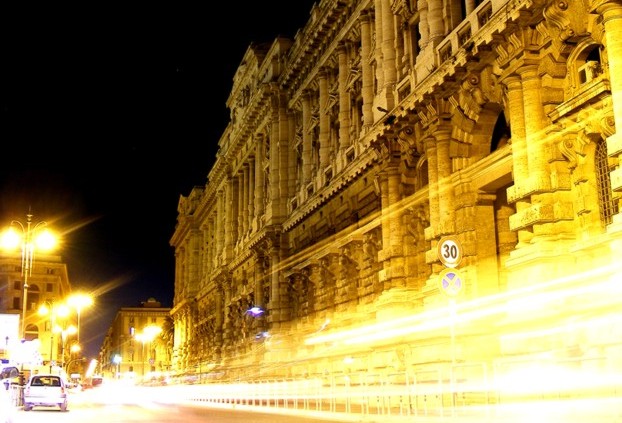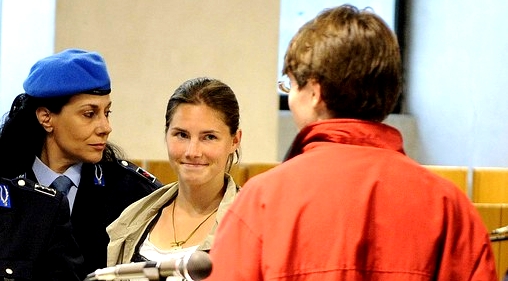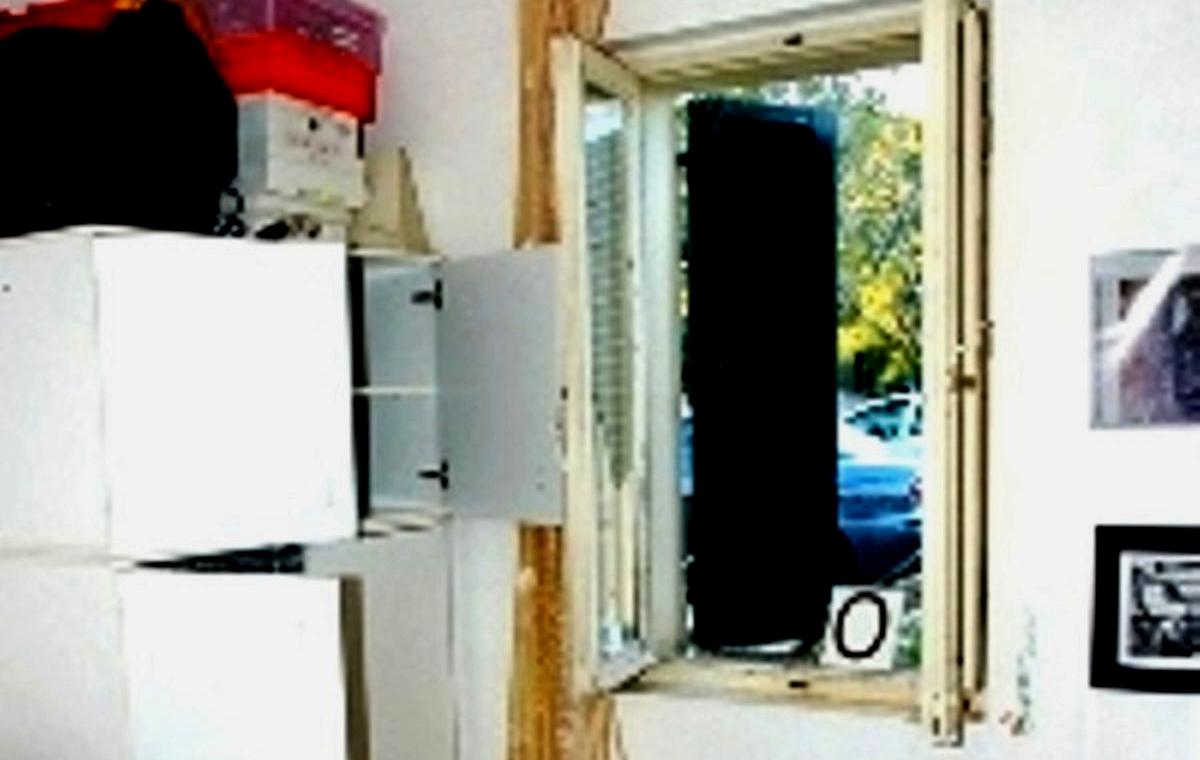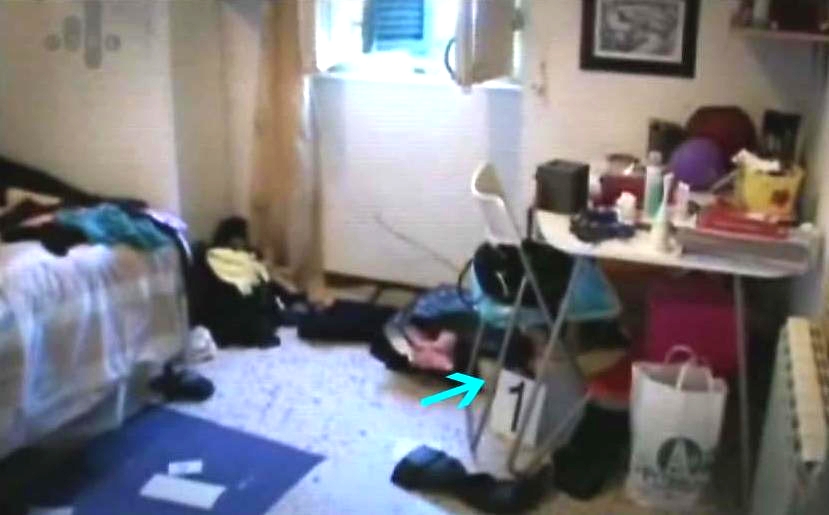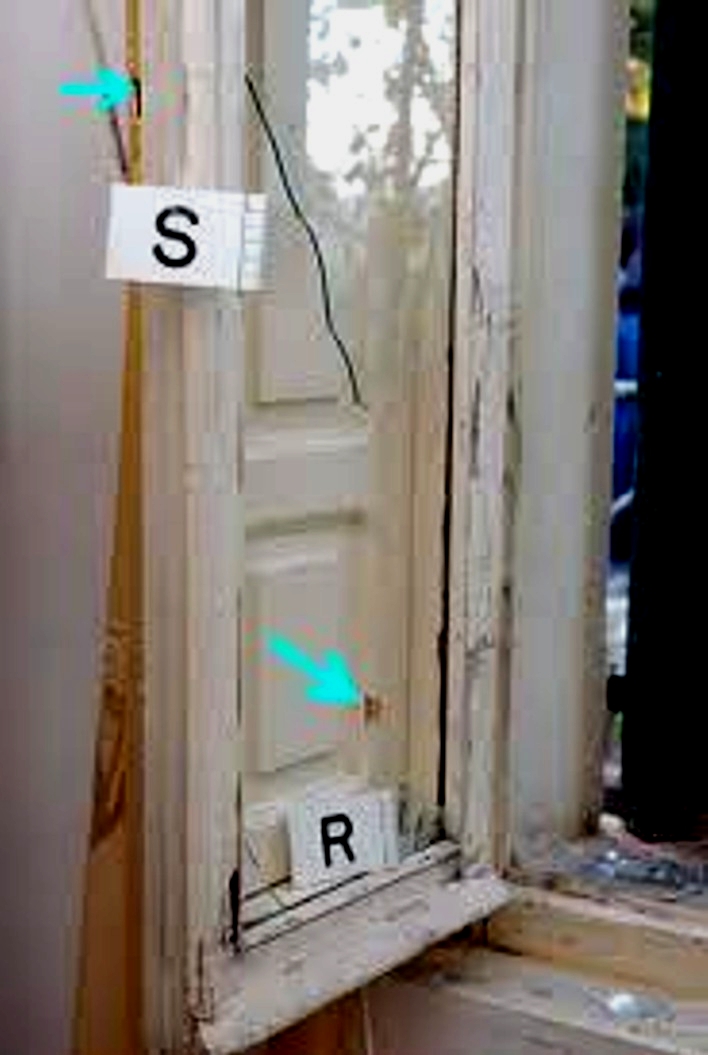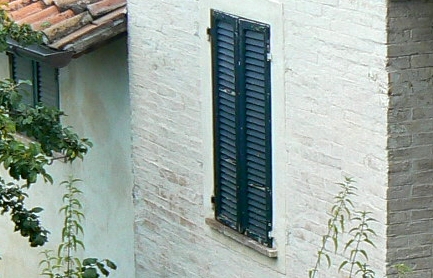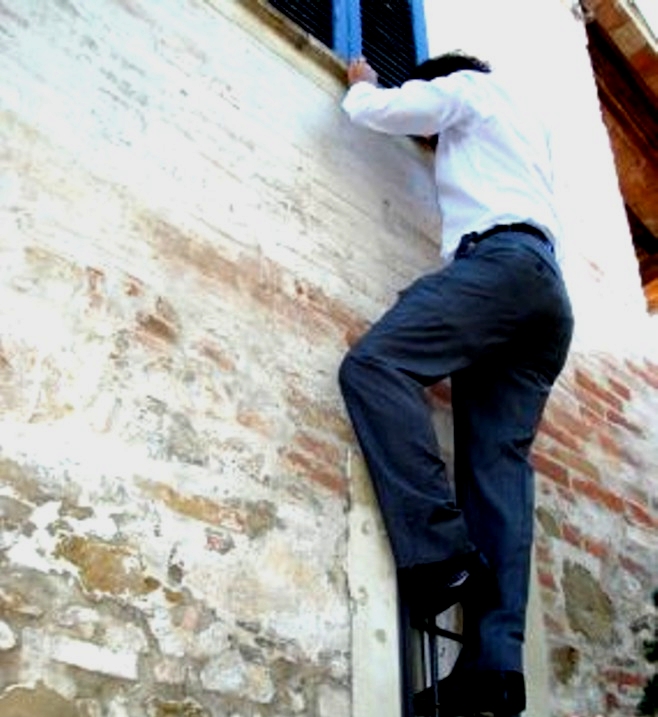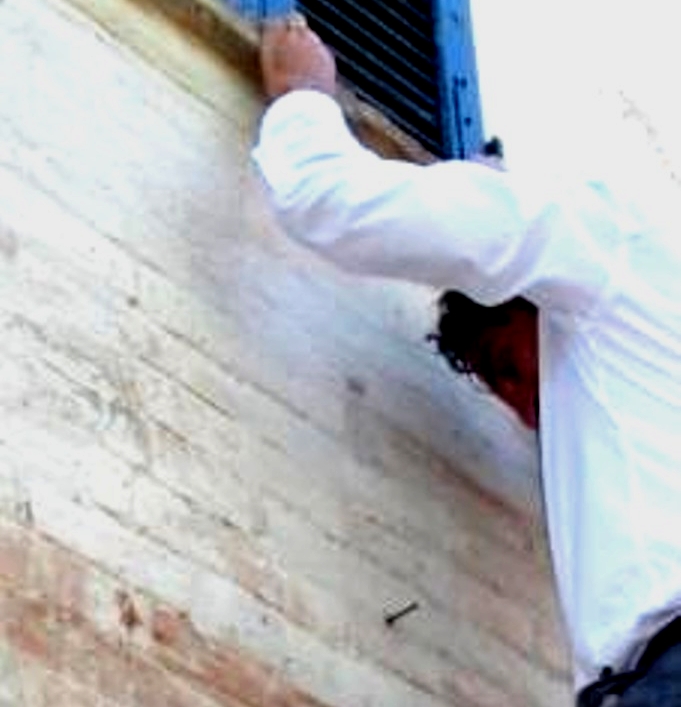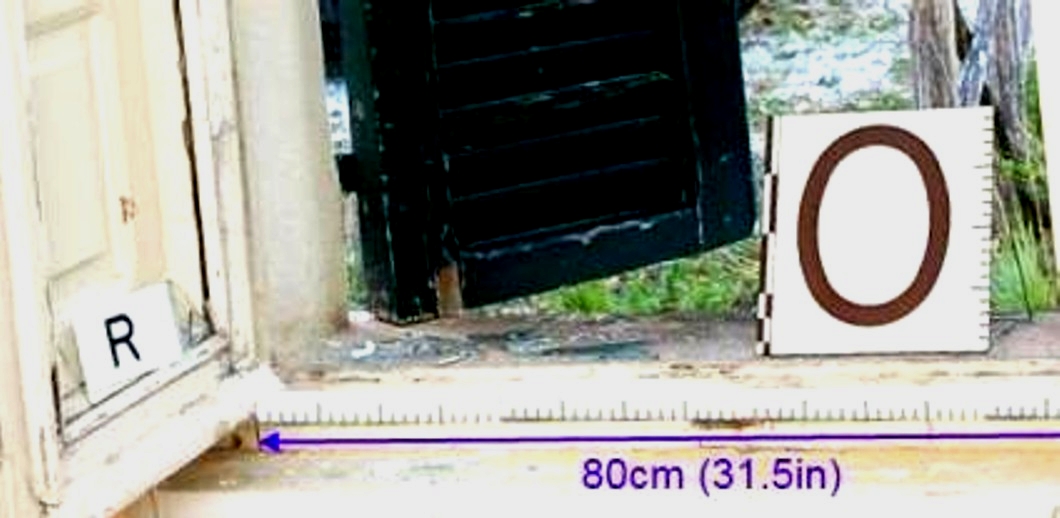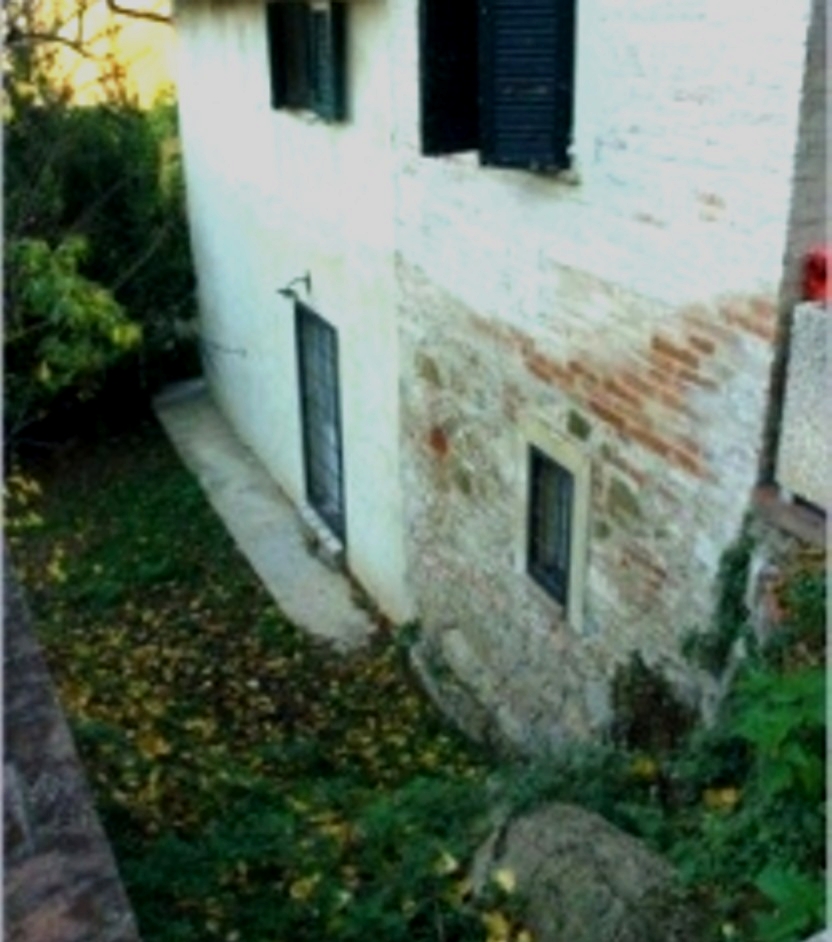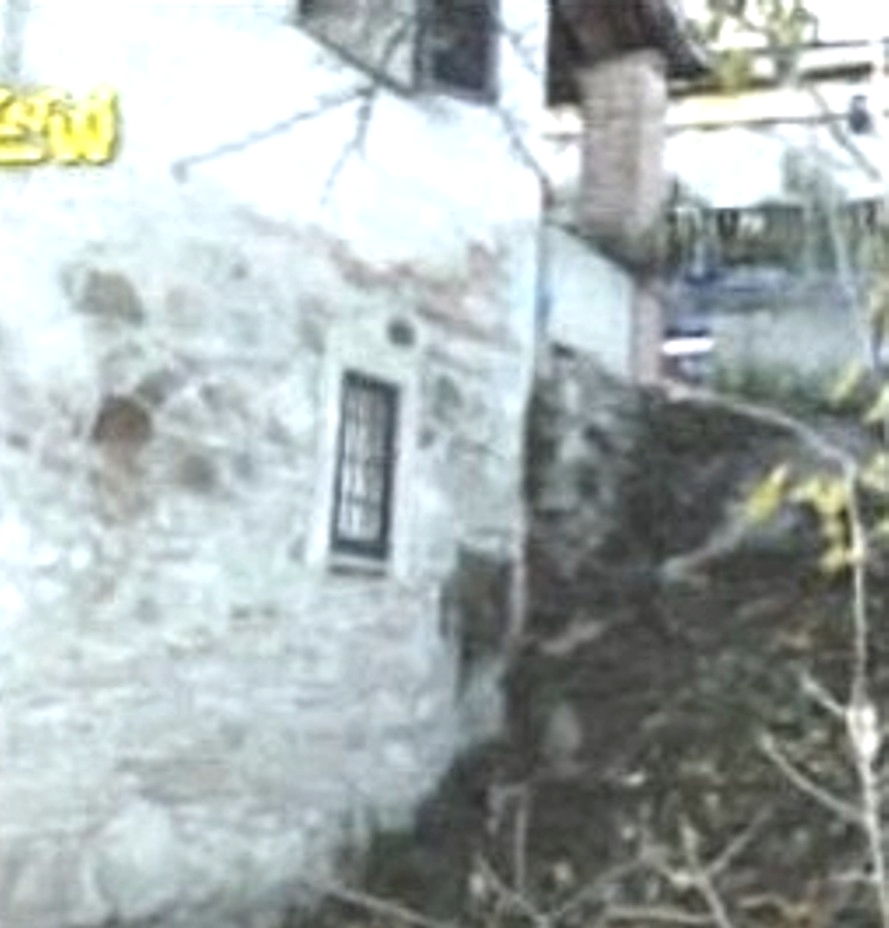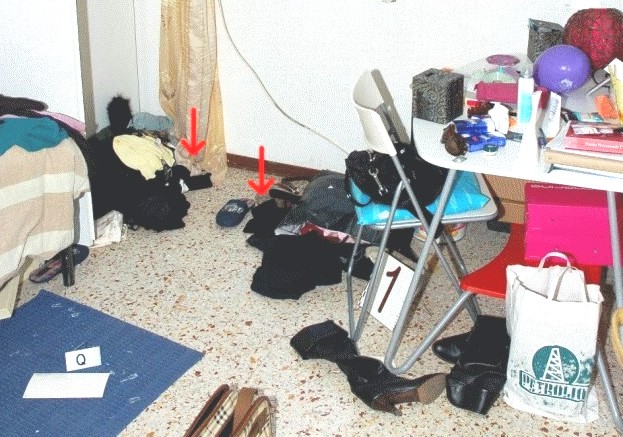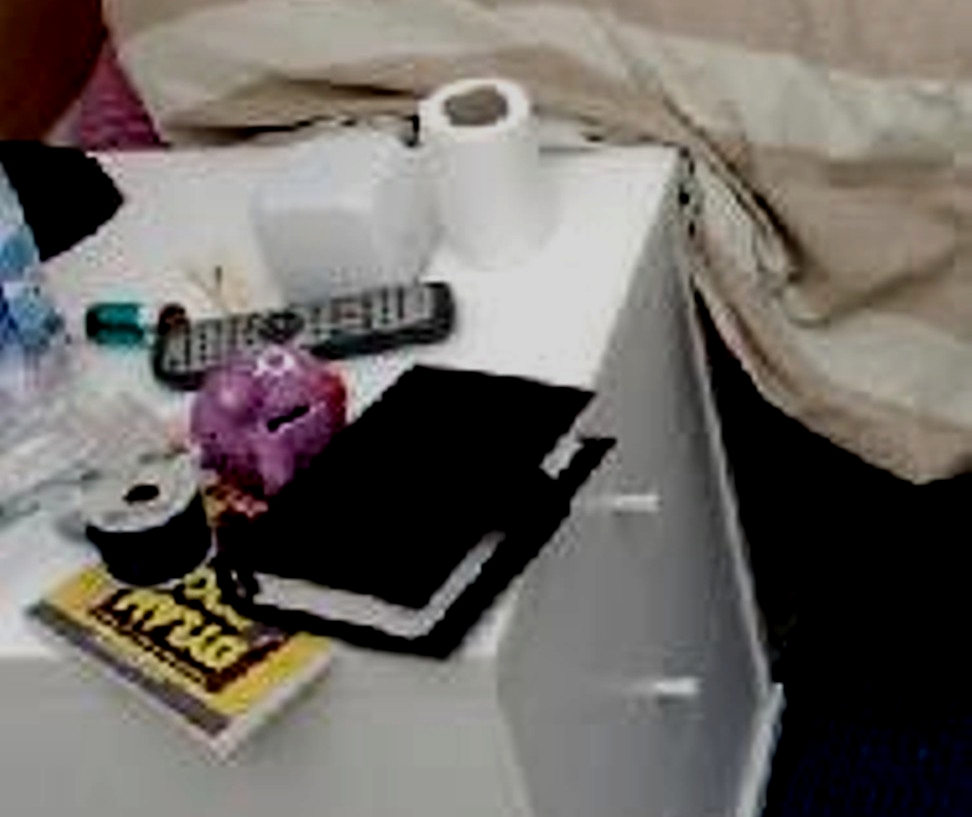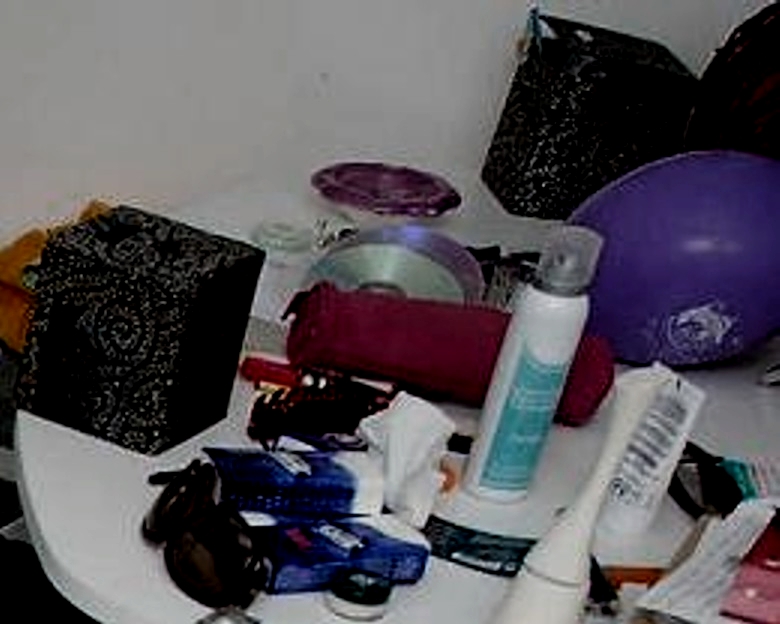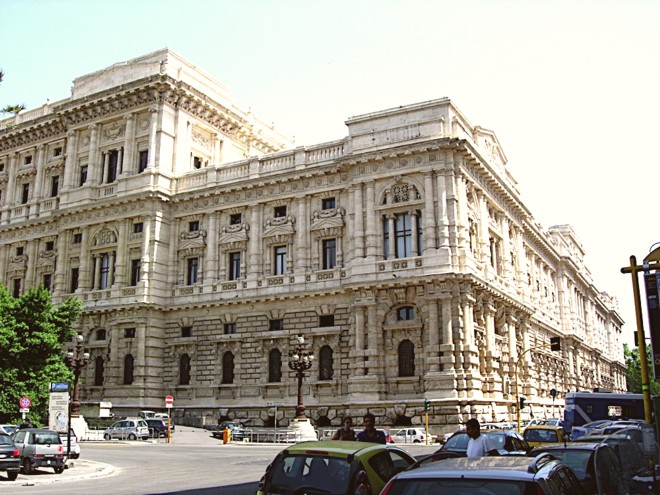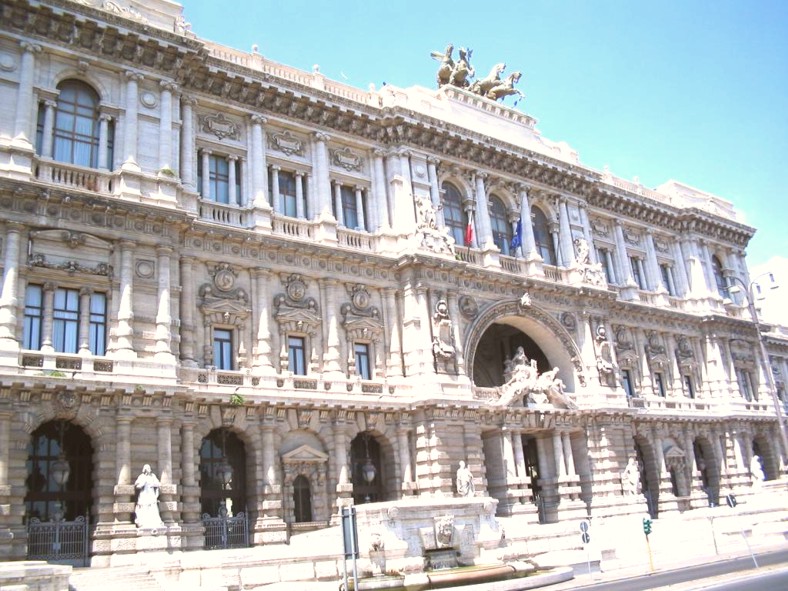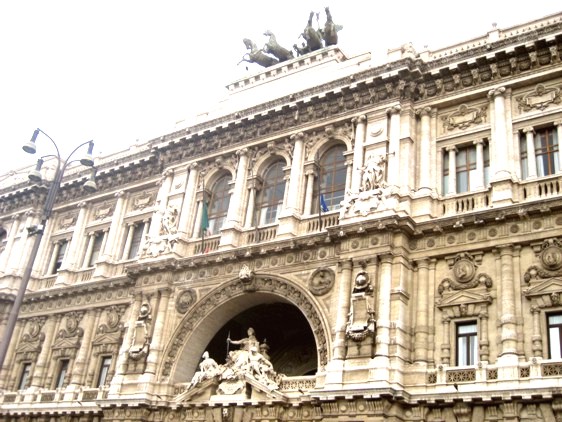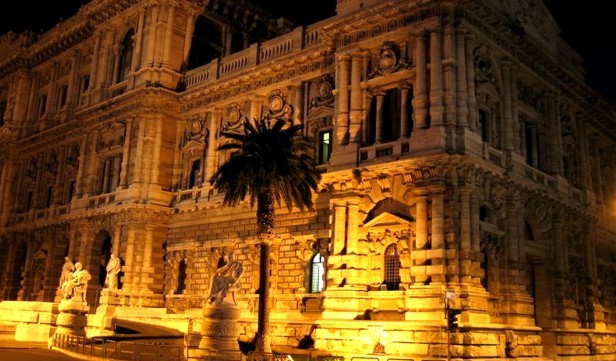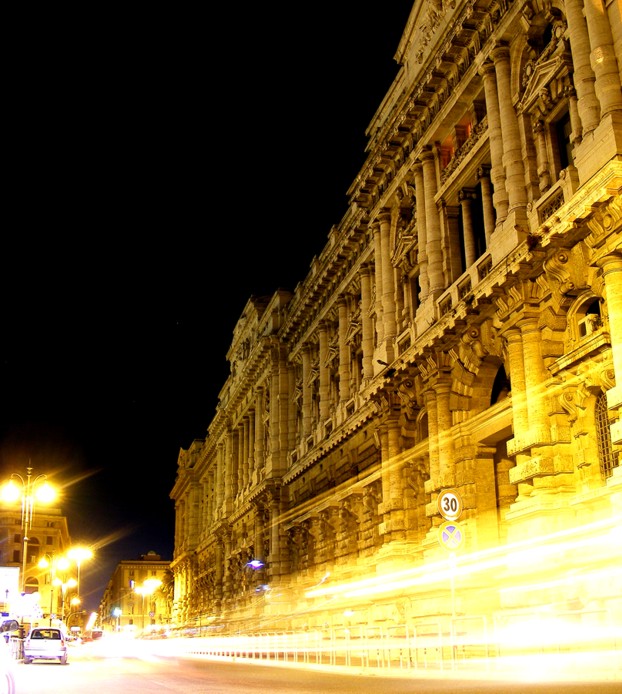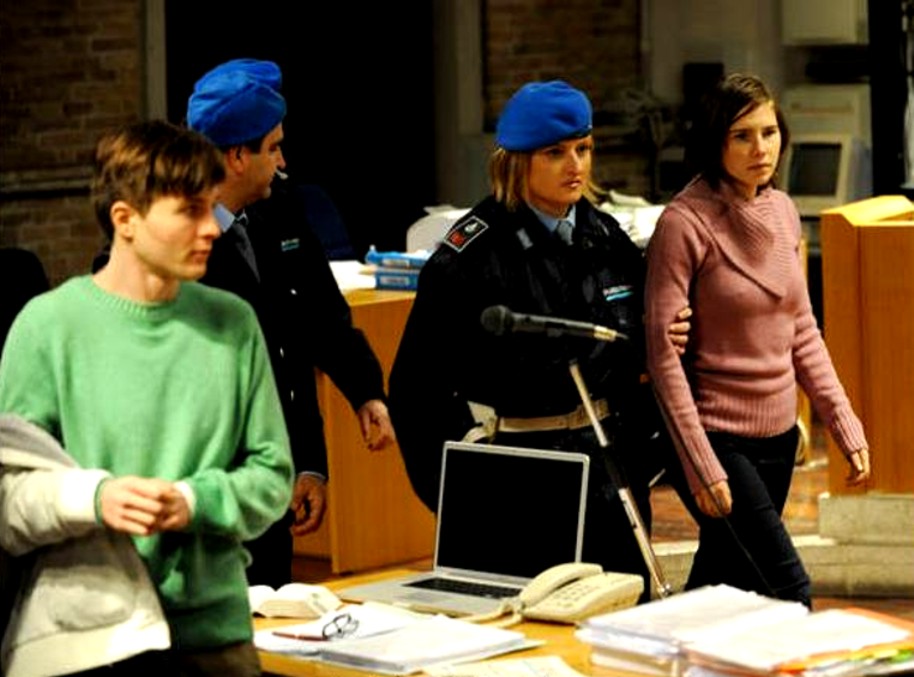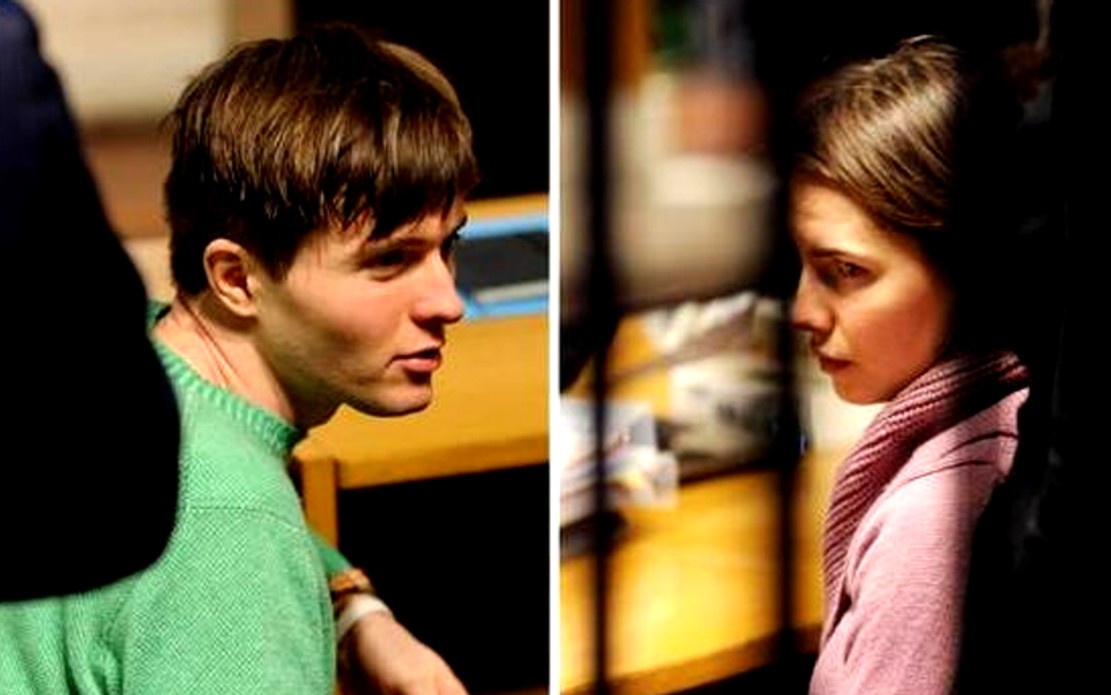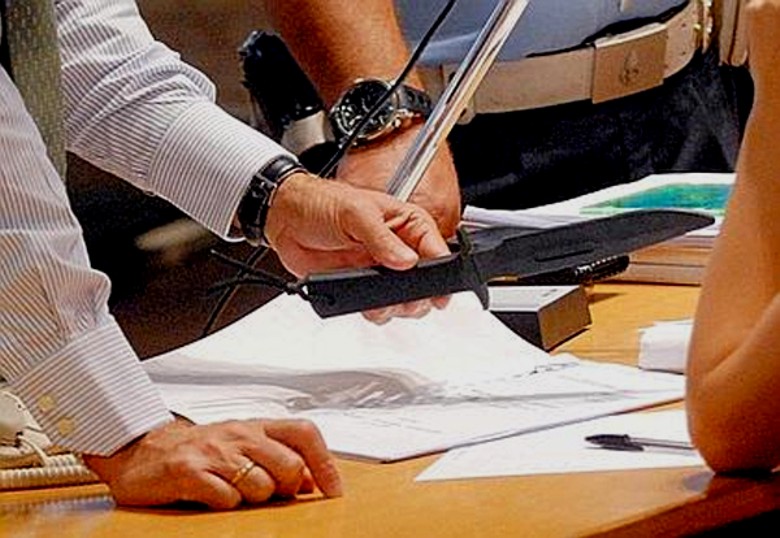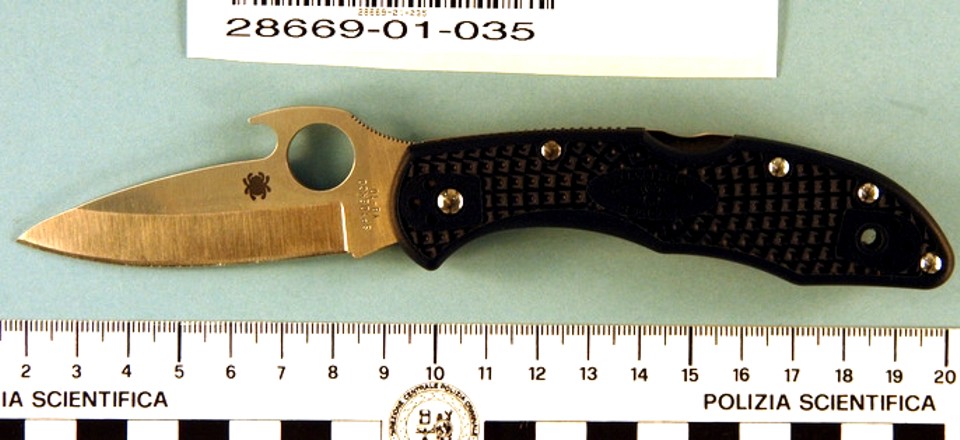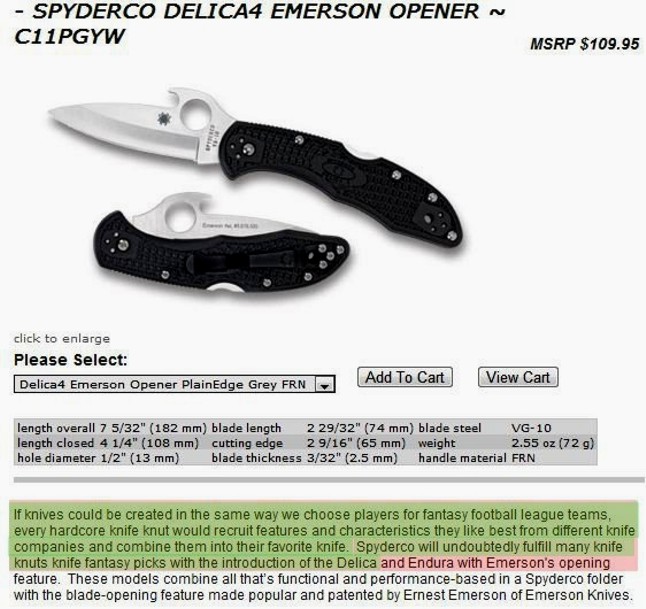
Category: 33 Sole attacker hoax
Sunday, May 22, 2011
So The Two Pressed Defense Teams Decide To Go Eyeball To Eyeball With Cassation
Posted by Peter Quennell
1. How Looks The Appeal?
The appeal is not looking very pretty for the defenses.
There seems no single brick in the wall of the prosecution’s case that, if pulled, will place the entire structure in doubt.
The Supreme Court ruled last December that at Rudy Guede’s trial, Judge Micheli had it right in saying that three perpetrators killed Meredith, one of which was definitely Rudy Guede.
Judge Micheli also ruled in October 2008 that only Knox had a reason to rearrange the crime scene, and Knox’s and Sollecito’s trial judge Massei ruled the same in December 2009.
The extensive forensic evidence in Filomena’s room, in the corridor, and in the bathroom Meredith and Amanda Knox shared, has so far been ruled out for re-examination.
None of it suggests Guede was ever in that bathroom or in Filomena’s room - in fact it suggests he headed straight out the front door .
Eye-witnesses other than the man in the park, Curatolo, are not to be heard from again.
Curatolo is probably not much discredited because he could say that it did not rain on the night he claims he saw Sollecito and Knox in the park watching the house (it did rain on Halloween) and that it was the night before all the cops arrived at the house. Buses were around as he described.
The only thing that might have shaken his timeline is that he might have seen a late Halloween reveler or two.
And the defenses seem to have no obvious way of explaining why Knox and Sollecito came up with so very many muddled alibis and why each at one point even ended up blaming the other.
A report today from TGCom said this on the review of two small parts of the DNA evidence:
Expert reports on the traces of DNA found on the knife held to be the murder weapon used to kill Meredith Kercher, and the clasp of the bra worn at the time of the murder, will be filed June 30.
This has been established by the 2011 Assize Court of Appeal in the Perugia trial of Raffaele Sollecito and Amanda Knox. The new deadline was set by the judges at the request of their experts who had requested an extension of 40 days.
The experts have been in the courtroom, explaining that they have obtained all the scientific data required.
They have however also highlighted the need to consult the minutes related to the seizure of the knife and the testimony in the 2009 trial of the agents that followed the inspection at the home of Sollecito. Documents that the Court ordered are to be provided to the experts.
In front of the judges one of the experts stressed that the “maximum cooperation” was provided by the scientific police who performed the technical tests in the course of the investigations.
Nothing in that looks too promising.
2. Best Defense Options Left?
What moves are available if Knox and Sollecito are really to be sufficiently suggested not guilty?
- Option 1: Putting both of them on the witness stand without preconditions for the first time so the appeal court can hear their stories in full, compare them, and subject Knox and Sollecito to no-holds-barred cross-examination.
- Option 2: Putting the two prison inmates Mario Alessi and Luciano Aviello on the witness stand, with several claimed corroborators, to say in Alessi’s case that Guede confided that he did it with two others, and to say in Aviello’s case that his missing brother did it with one other.
What we know of their claims so far - and police and prosecution have really checked out Alessi and Aviello and revealed nothing of what they have up their sleeves - there are only poor connects between their claims and what is described in the Micheli and Massei reports.
Each could crumble in a devastating way under cross-examination, and then be contradicted by a long line of witnesses that the prosecution could bring in to rebut them.
Here is Andrea Vogt reporting on Option 2 from the trial session yesterday which turned out to be mainly procedural: setting several new appeal court dates, and a new date for the findings of the reviews of the DNA on the large knife and bra clasp.
The parties eventually agreed to hold hearings June 18 and 27. And, surprisingly, Judge Hellmann also agreed to admit five new controversial witnesses into the appeals trial, a process normally reserved for debating contested evidence already introduced in the first trial.
The five new witnesses being requested by the Sollecito and Knox defense are all prison inmates ““ convicted of everything from child homicide to being Mafia snitches and drug dealing.
Some of the witnesses have given conflicting accounts of stories they’ve heard about the case while behind bars. At least three, however, agree on their version, that Rudy Guede told them that Knox and Sollecito were innocent (an account Guede denies).
The prosecution is likely to call for counter testimony. The decision to open up the appeal to wholly new testimony from convicted prison inmates is bound to complicate the already confused trial even more, and likely push any final decision far into the fall, toward the fourth anniversary of Kercher’s brutal stabbing and Knox’s incarceration in connection with it.
As if five convicts weren’t enough, Knox’s attorneys announced they had received yet another letter from a different inmate, Tommaso Pace, this time making bizarre and unfounded claims that victim Meredith Kercher was targeted by two unnamed brothers paid $100,000 to kill her over alleged drug debts.
The new letter from Pace (whom the judge and attorneys must still agree to call as a witness) sets up the prospect of potentially six prison inmates taking the stand in Knox’s defense over the summer””each of them with a slightly different story and motive for telling it.
Alessi’s own lawyer seems to have counseled him not to get up on the stand, presumably fearing perjury charges and additional time in his cell.
Aviello is literally unlikely to show his face.
The prosecution could bring back Rudy Guede as a witness against both, and even without Guede testifying, it looks like the prosecution might turn all five witnesses on their heads.
So Option 2 could drag things out for some months, and try to confront the unequivocal Supreme Court finding issued last December and ported into this appeal: no one wolf.
And still have the Knox and Sollecito defenses conclusively crumble.
Meanwhile, the judges and jury could be watching a very prolonged dog-and-pony show, while impatiently wondering:
“WHY didn’t they simply choose Option 1? Then some or all of us might very quickly have gone home.”
Tuesday, April 12, 2011
Explaining The Massei Report: How Motive For The Crime Is Addressed By Judge Massei
Posted by James Raper
The March 2010 Trial Sentencing Report
The Massei Report in the main I thought was excellent. He was incisive with his logic, particularly, though not exclusively, with regard to the staging of the break in and how that necessarily meant that Amanda was present at the scene when the murder was committed.
However, I thought that he was rather feeble in his coverage of the defendants’ motives as to the attack which led to this brutal murder.
Perhaps he thought it better to stick with the indisputable evidence. Since this pointed to a sex attack he surmised that Guede had a go at Meredith first, and then - because the stimulation was too much for them - he was joined by Amanda and Raffaele. This works but does seem a bit weak.
Micheli, the judge who committed Amanda and Raffaele to stand trial, was more certain in his mind as to the roles played by these three. He said that there was “an agreed plan”, “to satisfy sexual instincts” with “murderous intent” and that effectively Amanda was the instigator and catalyst.
Motive is largely an area of speculation but it is surely possible to draw inferences from what we know? As Micheli did. The Appeal Court and ultimately The Supreme Court of Cassation may well adopt the same reasoning and conclusion - maybe go further.
And there were, to my mind, undoubtedly many factors at work, and it is these which I wish to address. I have always been interested in the possible dynamics of just how these three came to murder poor Meredith. Pro-Knox campaigners once made much of “No Motive”. Now not so much, because the issue draws people in to a discussion of the evidence and of Amanda’s personality.
For instance, Massei asks, though he says we can not know, had Amanda egged Guede on as to the “availability” (my word, not his) of Meredith during or prior to their presence at the Cottage?
Frankly the answer to that has to be “yes” since it is a bit difficult to figure out why Amanda and Raffaele would otherwise wish Guede to join them at the cottage. I doubt that Amanda and Raffaele would have wanted Guede around if they were just going there to have an innocent cuddle and sex and to smoke cannabis, as Massei implies. The evidence is that Raffaele hardly knew Guede and in the presence of Amanda was very possessive about her. If he had known of Guede’s interest in Amanda, he would have been even less keen to have Guede around.
Also, if all was so innocent beforehand, then why would Guede have tried it on with Meredith, and then pressed the situation in the face of her refusal to co-operate? Knowing that there were two others there who could have come to her assistance?
The answer is of course that Guede knew full well in advance that there would be no problem with Amanda and Raffaele. He had been invited there, and primed to act precisely in the way he did, at least initially. Why? Well there is plenty of evidence as to why Amanda, in her mind, may have been looking for payback time on Meredith. Come to that later.
What does not get much attention in the Massei Report, other than a terse Not Proven at the end, is the matter of Meredith’s missing rent money and credit cards and whether Amanda and Raffaele stole them. It is as if the Judge (well, the jury, really) felt that this was a trivial issue that brought nothing much to the case, and thus it was not necessary to give it much attention. And indeed there is no summation of or evaluation of that evidence.
Now that does surprise me. Of course there may have been some technical flaw with the charge and the evidence. But in the absence of any comment on this then we do not know what that may be.
What I do know is that the matter, if proven, is not trivial. A theft just prior to the murder significantly ups the stakes for Amanda and Raffaele, and produces a dynamic, which, threaded together with a sexual assault, makes for a far more compelling scenario to murder. It also leads one to conclude that there was a greater degree of premeditation involved: not premeditation as to murder, but as to an assault, rather than the more spontaneous “let’s get involved” at the time of the sex attack as postulated by Massei.
What is the evidence? What evidence was before the court? I do not yet have access to trial records. Therefore I stand to be corrected if I misrepresent the evidence, or if my interpretation of it does not met the test of logic.
There were two lay witnesses to whom we can refer. The first was Filomena Romanelli, the flatmate and trainee lawyer. If there was anyone who was going to ensure that the rent was paid on time, it would have been her. She gave evidence that, the rent being due very soon, she asked Meredith about her contribution of 300 euros, and was told by Meredith that all was OK because she had just withdrawn 200 euros from her bank. Filomena assumed from Meredith’s reply that the balance was already to hand.
Is there a problem with this evidence? Is it hearsay and thus inadmissible under Italian law?
Perhaps it is not enough by itself because of course had Meredith not in fact withdrawn the money from her bank, or sufficient funds to cover the stated amount, then that would be a fatal blow to that part of the theft charge. Her bank manager was summoned to give evidence, essentially to corroborate or disprove Filomena’s testimony. I do not know what exactly that evidence was. One would assume that at the very least it did not disprove her testimony. Had it done so, that would as I have said been fatal. It is also unbelievable that Massei would have overlooked this in the Report. I am assuming that Meredith did not tell a white lie, and that the bank records corroborate this.
There may of course be an issue of timing as I understand that the bank manager told the court that transactions at a cash machine are not necessarily entered on the customer account the same day . However that does not seem to me to be significant.
One must also think that the bank manager was asked what other cash withdrawals had been made if the credit cards were taken at the same time as the money.
I understand that there is of course a caveat here: my assumptions in the absence of knowing exactly what the bank manager’s evidence was.
It would be useful also to know how and when the rent was normally paid. It sounds as if it was cash on the day the landlord came to collect.
We do know that the police did not find any money, or Meredith’s credit cards. Had Meredith, a sensible girl, blown next month’s rent on a Halloween binge? Unlikely. So somebody stole it. And the credit cards? Again, just as with the fake break in, when according to Amanda and Raffaele nothing was stolen, who and only who had access to the cottage to steal the money? Yes, you have guessed it. Amanda, of course.
Does the matter of missing rent money figure anywhere else? There is the evidence of Meredith’s phone records which show that a call was placed to her bank late on the evening of her murder just prior to the arrival of Amanda, Raffaele and Guede. Why? I have to concede that there is no single obvious reason and that it may be more likely than not that the call was entirely unintentional.
But if, as may seem likely, the credit cards were kept with her handbag, and the money in her bedroom drawer, then on discovering that her money was missing she may have called her bank in a funk, only to remember that the cards were safe and that no money could be withdrawn from her account.
The missing money also figured in the separate trial of Guede. He made a statement which formed the whole basis of his defence. Basically this was that he had an appointment with Meredith at the cottage, had consensual foreplay with her, and was on the toilet when he heard the doorbell ring etc, etc. What he also added was that just before all this Meredith was upset because her rent money had disappeared and that they had both searched for it with particular attention to Amanda’s room.
Now why does Guede mention this? Remember this is his defence. Alibi is not quite the right word. He had plenty of time to think about it or something better. His defence was moulded around (apart from lies) (1) facts he knew the police would have, ie no point denying that he was there, or that he had sexual contact with Meredith: his biological traces had been left behind; and (2) facts known to him and not to the police at that stage, ie the money, which he could use to make his statement as a whole more credible, whilst at the same time giving the police a lead. He is shifting the focus, if the police were to follow it up, on to the person he must have been blaming for his predicament, Amanda.
If all three, Amanda, Raffaele and Guede, went to the cottage together, as Massei has it, then Guede learns about the missing rent money, not in the circumstances referred to in his statement, but because Meredith has already discovered the theft, and worked out who has had it, and challenges Amanda over it when the three arrive. Perhaps this is when Guede goes to the toilet and listens to music on his Ipod. After all he is just there for the sex and this is all a distraction.
Although Micheli thought Guede was a liar from start to finish, he did not discount the possibility that Guede was essentially telling the truth about the money. Guede expanded upon this at his appeal, telling the court that Amanda and Meredith had an argument and then a fight over it. It is a thread that runs through all his accounts, from his Skype chat and initial statements in Germany to his final appeal.
Guede’s “evidence” was not a factor in the jury’s consideration at Amanda’s and Raffaele’s trial. Although he was called to give evidence he did not do so. Now his “evidence” and the findings and conclusion of the courts which processed his case come in to play in the appeal of Amanda and Raffaele.
When were the money and credit cards stolen?
I have to accept that, as to the money, at any rate a theft prior to the murder is critical to sustain the following hypothesis. The credit cards were in any event probably taken after the attack on Meredith.
According to Amanda and Raffaele they spent Halloween together at Raffaele’s, and the next day went to the cottage. Meredith was there, as was Filomena. Filomena left first, followed by Meredith to spend the evening with her friends, and Amanda and Raffaele left some time afterwards.
So Amanda and Raffaele could have stolen the money any time after Meredith left and before she returned at about 9.30pm - the day of her murder. Incidentally Filomena testified that Meredith never locked the door to her room except on the occasions she went home to England. Meredith was a very trusting girl.
What motive had Amanda for wanting the money, apart from the obvious one of profit?
There are numerous plausible motives.
To fund a growing drugs habit which she shared with Raffaele? Not an inconsiderable expense for a student. Both Amanda and Raffaele explained during questioning that their confusion and hesitancy was due to the fact that they had been going rather hard on drugs. Mignini says that they were both part of a drugs crowd.
Because her own financial circumstances were deteriorating, and to fund her own rent contribution? She was probably about to be sacked at Le Chic, where she was considered by Lumumba to be flirty and unreliable, and to add insult to injury would likely be replaced by Meredith. In fact Meredith was well liked and trusted by all, whereas Amanda’s star was definitely on the wane.
But maybe Amanda just also wanted to get her own back on Meredith.
Filomena testified that Meredith and Amanda had begun to have issues with each other.
Here are some quotes from from Filomena in “Darkness Descending”.
At first they got on very well. But then things began to take a different course. Amanda never cleaned the house, so we had to institute a rota… then she (Amanda) would bring strangers home… Meredith said she was not interested in boys, she was here to study.
Meredith was too polite to confront Amanda, but she did confide in her pal, Robyn Butterworth. Robyn winced in disbelief when Meredith said that the pair had quarreled, because Knox often failed to flush the toilet, even when menstruating. Filomena began noticing that Amanda could be odd, even mildly anti-social.
It seems that Amanda did not like it when she was not the centre of attention. It was observed that, comically if irritatingly, she would sing loudly if conversation started to pass her by, and when playing her guitar would often strum the same chord over and over again.
On the evening of Halloween, Amanda texted Meredith enquiring as to whether they could meet up. But Meredith had other arrangements. Meredith appeared to be having a good time, whereas Amanda was not.
Indeed there has been much speculation that Amanda has always had deep seated psychological problems and that after just several weeks in Perugia her fragile and damaged ego was tipping towards free fall.
With Meredith’s money, both Amanda and Raffaele could have afforded something a little stronger than the usual smoke, and I speculate that they spent the late afternoon getting stoned.
Of course Amanda was still an employee of Lumumba, and she was supposed to turn up that evening for work, but perhaps she no longer cared all that much for the consequences if she did not.
Again I speculate, that she, with or without Raffaele, met Guede at some time - perhaps before she was due at work, perhaps after she learnt that she was not required by Lumumba - and discussed Meredith’s “availability” and agreed to meet up again on the basketball court at Grimana Square.
The notion that Amanda and Guede hardly knew each other seems implausible to me. We know that they met at a party at the boys’ flat at the cottage. Guede was friends with one of those boys and was invited there on a number of occasions. He was ever-present on the basketball court in Grimana Square, which was located just outside the College Amanda and Meredith attended, and just metres from the cottage. He was known to have fancied Amanda, and Amanda was always aware of male interest.
What else did Amanda and Raffaele have in mind when arranging the meeting or when thinking about it afterwards?
Guede was of course thinking about sex and that Amanda and Raffaele were going to facilitate an encounter with Meredith later that evening. However Amanda and Raffaele had something else on their minds. The logic of their position vis a vis Meredith cannot have escaped them. They had taken her money whilst she was out.
Had she not already discovered this fact then she would in any event be back, notice the money was missing and would put 2 and 2 together. What would happen? Who would she tell? Would she call the police? How are they going to deal with this? Obviously deny it, but logic has its way, and the situation with or without the police being called in would be uncomfortable.
They decided to turn the tables and make staying in Perugia uncomfortable for Meredith? Now the embarrassing, for Meredith, sexual advances from Guede were going to be manipulated by them in to a sexual humiliation for Meredith. Meredith was not going to be seriously harmed, but as and when they were challenged by Meredith over the missing money, as inevitably they would be, she was to be threatened with injury or worse. Knives come in useful here.
Amanda may have fantasized that Meredith would likely then give up her tenancy at the cottage, perhaps leave Italy. Whether that looks like the probable and likely outcome, I leave you to judge, but the hypothesis is that they were starting to think and behave irrationally and that this was exacerbated by the use of drugs.
In the event there came a point when neither Amanda nor Raffaele had any other commitments anyway. They got to the basketball court. They waited for Guede.
We know Amanda and Raffaele were on the basketball court the evening of the 1st November. This is because of the evidence of a Mr Curatolo, the second lay witness. He was not precise about times but thought that they were on the basketball court between 9.30pm and 10pm and may have left around 11.00 - 11.30pm and then returned just before midnight.
In any event he testified to seeing Amanda and Raffaele having heated arguments, and occasionally going to the parapet at the edge of the court to peer over. What were they looking at? Go to the photographs of Perugia on the True Justice for Meredith website, and you will see. From the parapet you get a good view of the iron gates that are the entrance, and the only entrance as I understand it, to the cottage.
So why the behaviour observed by Mr Curatolo? They may have been impatient waiting for Guede to arrive. Were they actually to go through with this? Was Meredith at home, alone, and had she found the money was missing and had she called the police or tipped off someone already? Who was hanging around outside the entrance to the cottage and why?
There was, apparently, a car parked at the entrance, a broken down car nearby with the occupants inside awaiting a rescue truck, and the rescue truck itself, all present around 11.00pm. Amanda and Raffaele did not wish to be observed going through the gates with these potential witnesses around.
We of course cannot know for certain what went on in the minds of Amanda and Raffaele between the time of them leaving the cottage and their departure from the basketball court to return to the cottage. It has to be speculation, but there is a logical consistency to the above narrative if they had stolen Meredith’s money earlier that day, and their meeting up with Guede just before leaving the basketball court does not look like a coincidence.
From there on in to the inevitable clash between Amanda and Meredith over the money.
It is my opinion that at the cottage Amanda came off worse initially: that she got caught in the face by a blow and suffered a nose bleed.
Experts Stefanoni and Garofano both say that there was an abundant amount (relatively speaking) of Amanda’s blood in the bathroom washbasin, and to a lesser extent the bidet. Whereas most of Amanda’s blood in the bathroom was mixed with Meredith’s, the blood on the washbasin tap was Amanda’s alone. Both of a quality and quantity to discount menstrual (from washed knickers) or bleeding from ear-piercing. Their conclusion was that Amanda bled fairly profusely though perhaps briefly at some stage.
Possibly Amanda may have cut her feet on glass in Filomena’s bedroom but if so it’s difficult to see how blood from that ends up as a blob on the basin tap and in the sink, and cut feet are painful to walk on and she did not display any awkwardness on her feet the next day.
Amanda’s blood may have come from a nick by a blade to her hands. I think the nick would be obvious the next day. If so, she was not hiding it. She was photographed the next day outside the cottage waving her hands under the noses of a coterie of vigilant cops.
She might have got a bloody nose during the attack in Meredith’s bedroom save that there is no evidence of her blood there.
On the other hand if she got into a tussle with Meredith (say in the corridor outside their rooms and where there was little room for other than the two to be engaged) and was fended off with a reflex blow that accidentally or otherwise connected with her nose, Amanda’s natural reaction would be to disengage immediately and head for the bathroom sink to staunch the flow of blood.
A nose-bleed need not take too long to staunch, especially if not serious and if there is no cut (certainly none being visible the next day). Just stuff some tissue up the offending nostril. A nose bleed is not necessarily something of which there would be any sign the next day.
Raffaele fusses around her, whilst Rudy briefly plays peacemaker. But Amanda is boiling. As furious with Raffaele and Guede as she is with Meredith. She eggs Guede on and pushes him towards Meredith. Raffaele proudly produces his flicknife, latent sadistic instincts surfacing.
Is a scene like this played out inside the cottage or outside? I think of the strange but sadly discredited tale told by Kokomani.
In any event motive is satiated and the coil, having been tensed, is sprung for the pre-planned, but now extremely violent, hazing of poor Meredith.
I am also thinking here of Mignini’s “crescendo of violence” and where a point is reached where anything goes ““ where there is (from their warped perspectives) almost an inevitability or justification for their behaviour. A “Meredith definitely needs teaching a lesson now!” attitude.
Psychology is part of motive and there is much speculation particularly with regard to Amanda and Raffaele. They have both been in prison for well over three years now and during this time psychological assessments will certainly have been carried out.
Based on specific incidents and and general patterns of behaviour, speech and language, and demeanour, some preliminary conclusions will have been reached correlated with the facts of the crime.
If their convictions are upheld, these assessments may be relevant to sentence insofar as they shed light on mitigation and motive.
Tuesday, February 01, 2011
Explaining The Massei Report: A Visual Guide To The Faked Break-In Via Filomena’s Window
Posted by pat az
1. Post Overview
Cross-posted from my own website on Meredith’s case at the kind invitation of TJMK.
The Massei Report on the trial and sentencing of Amanda Knox and Raffaele Sollecito looks into whether or not a break-in is supported by the evidence available in the room with the broken window.
It concludes that the broken window and room in disarray - Filomena’s bedroom - are an “artificial representation”, ie. that the break-in was faked. After seven pages of review of the evidence, the Massei Report states:
“the situation of disorder in Romanelli’s room and the breaking of the window pane constitute an artificial representation created in order to orient the investigations towards a person who, not having the key to the front door, was supposed to have entered through the previously broken window and then effected the violent acts on Meredith which caused her death.
What follows is a look at the comments in the Massei report compared with crime scene and other photos. All quotes are from the English translation prepared by unpaid volunteers at PerugiaMurderFile.org. The section on the scenes in the bedroom begins on page 47 and continues to page 55. Some sentences in the paragraphs below have been omitted for brevity, and can be read in full in the original.
2. Knox Finds The Scene
Then (Amanda) went into another room and noticed that the window had been broken and that there was glass inside. She told these things to her and the other girls present. Then she related that she had gone back to Raffaele’s house and had rung Filomena.
I)n one of the telephone calls to Romanelli, Amanda spoke of that smashed window and of the possibility that someone could have entered the house through the broken place; she said this also in the telephone call to 112 and in the first declarations to the Postal Police.
Also in the e-mail of November 4, 2007, sent by Amanda to 25 people in the US, she hypothesises that a burglar could have entered the house and says she looked around to see if anything was missing.
Filomena Romanelli, disturbed by this phone call, had rung Amanda back without receiving a reply and when, a little later, she had succeeded in speaking to Amanda, Amanda had told her that in her room (i.e., in Ms. Romanelli’s room) the windowpane was broken, everything was in a mess, and that she should come back home.
Filomena Romanelli had ascertained from a quick check of her room, even though (it was) in a complete mess with the windowpane broken, that nothing was missing.
It must be held that when Filomena Romanelli left the house in via della Pergola, she had pulled the [interior] shutters towards the interior of her room, although she did not think that she had actually closed them; furthermore, because they were old and the wood had swelled a bit, they rubbed on the windowsill; to pull them towards the room it was necessary to use some force (“they rubbed on the windowsill”); but in this way, once they had been pulled in, as Romanelli remembered doing, they remained well closed by the pressure of the swelled wood against the windowsill.
It cannot be assumed - as the Defence Consultant did - that the [interior] shutters were left completely open, since this contradicts the declarations of Romanelli, which appear to be detailed and entirely likely, considering that she was actually leaving for the holiday and had some things of value in her room; already she did not feel quite safe because window-frames were in wood without any grille.
Also, the circumstance of the [interior] shutters being wide open does not correspond to their position when they were found and described by witnesses on November 2, and photographed (cf. photo 11 already mentioned).
Now, for a rock to have been able to break the glass of the window without shattering the outside shutters, it would have been necessary to remove the obstacle of the shutters by opening them up.
Consequently, since the shutters had been pulled together and their rubbing put pressure on the windowsill on which they rested, it would have first been necessary to effect an operation with the specific goal of completely opening these shutters.
The failure to find any instrument suitable for making such an opening (one cannot even see what type of instrument could be used to this end) leads one to assume that the wall would have to have been scaled a first time in order to effect the complete opening of the shutters, in order to enable the burglar to aim at the window and smash it by throwing a large stone - the one found in Romanelli’s room.
He would then have to have returned underneath Romanelli’s window for the second climb, and through the broken glass, open the window (balanced on his knees or feet on the outside part of the windowsill), otherwise he would not have been able to pass his arm through the hole in the glass made by the stone) and reach up to the latch that fastened the window casements, necessarily latched since otherwise, if the casements had not been latched, it would not have been necessary to throw a rock at all, but just to open the shutters and climb inside.
The “climber” would also need to rely on the fact that the [interior] shutters were not actually latched, and also that the “scuri” ]blackout blind] had not been fastened to the window-frame to which the broken pane was attached; otherwise it would not have been possible to open them from the outside; nor would it have been possible, even breaking the glass, to make a hole giving access to the house, since if these inner panels had been closed, they would have continued to provide an adequate obstacle to the possibility of opening the window, in spite of the broken pane.
This scenario appears totally unlikely, given the effort involved (going twice underneath the window, going up to throw the stone, scaling the wall twice) and taking into account the uncertainty of success (having to count on the two favourable circumstances indicated above), with a repetition of movements and behaviours, all of which could easily be seen by anyone who happened to be passing by on the street or actually coming into the house.
But beyond these considerations, there are other elements which tend to exclude the possibility that a burglar could have entered the house through the window of Romanelli’s room.The double climb necessary to attain the height of three and a half metres would have left some kind of trace or imprint on the wall, especially on the points on the wall that the “climber” would have used to support his feet, all the more as both the witnesses Romanelli and Marco Zaroli gave statements indicating that the earth, on that early November evening, must have been very wet (..6) (p50)
In fact, there are no visible signs on the wall, and furthermore, it can be observed that the nail ““ this was noted by this Court of Assizes during the inspection ““ remained where it was: it seems very unlikely that the climber, given the position of that nail and its characteristics, visible in the photo 11, did not somehow “encounter” that nail and force it, inadvertently or by using it as a foothold, causing it to fall or at least bend it. (p50)
The next fact to consider is that the pieces of glass from the broken pane were distributed in a homogeneous manner on the inside and outside parts of the windowsill, without any displacement being noted or any piece of glass being found on the ground underneath the window.
This circumstance, as confirmed also by the consultant Pasquali, tends to exclude the possibility that the rock was thrown from outside the house to create access to the house through the window after the breaking of the pane. The climber, in leaning his hands and then his feet or knees on the windowsill, would have caused at least some piece of glass to fall, or at least would have been obliged to shift some pieces of glass in order to avoid being wounded by them.
Instead, no piece of glass was found under the window, and no sign of any wound was seen on the pieces of glass found in Romanelli’s room. It can moreover be observed that the presence of many pieces of glass on the outside part of the windowsill increases the probability of finding some small pieces of glass on the ground underneath, since there seems to be no reason that so many pieces of glass would all stop just at the edge of the windowsill without any of them flying beyond the edge and falling down to the garden below. (p51 & 52)
On this subject it is also useful to recall that at the hearing of April 23, 2009, the witness Gioia Brocci mentioned above declared that she had observed the exterior of the house, paying particular attention to the wall underneath the window with the broken pane, the window of the room then occupied by Filomena Romanelli.
She said: “We observed both the wall”¦underneath the window and all of the vegetation underneath the window, and we noted that there were no traces on the wall, no traces of earth, of grass, nothing, no streaks, nothing at all, and none [39] of the vegetation underneath the window appeared to have been trampled; nothing” (p. 142 declarations of Gioia Brocci). (51)
This situation, like all the other glaring inconsistencies, is adequately and satisfactorily explained if one supposes that the rock was thrown from the inside of the room, with the two shutters pulled inwards so that they blocked the pieces of glass from falling to the ground below. Once the glass had been broken from inside, the rock was set down at some place in the room, and the shutters were pushed towards the outside, being thus opened from within the room. (p51)
But the fact that all this was in fact just a simulation, a staging, can be deduced from further circumstances. From the photos taken by the personnel of the Questura (photos 47 to 54 and 65 to 66) one can perceive an activity which appears to have been performed with the goal of creating a situation of obvious disorder in Romanelli’s room, but does not appear to be the result of actual ransacking, true searching for the kind of valuable objects that might tempt a burglar.
The drawers of the little dresser next to the bed were not even opened (photo 51 and declarations of Battistelli who noted that Romanelli was the one who opened the drawers, having found them closed and with no sign of having been rifled: see p. 66 of Battistelli’s declarations, hearing of Feb. 6, 2009).
The objects on the shelves in photo 52 appear not to have been touched at all; piles of clothes seem to have been thrown down from the closet (photo 54) but it does not seem that there was any serious search in the closet, in which some clothes and some boxes remained in place without showing any signs of an actual search for valuable items that might have been there (photo 54).
It does not appear that the boxes on the table were opened (photo 65) in a search for valuable items. And indeed, no valuable item (cf. declarations of Romanelli) was taken, or even set aside to be taken, by the ““ at this point we can say phantom ““ burglar.
What has been explained up to now thus leads to the assertion that the situation of disorder in Romanelli’s room and the breaking of the window pane constitute an artificial representation created in order to orient the investigations towards a person who, not having the key to the front door, was supposed to have entered through the previously broken window and then effected the violent acts on Meredith which caused her death.
Footnotes
(...1) The Massei Report in English is readable and downloadable via the link at the top of this page.
(..2) The consultant for the defence actually assumed that this had been done; in his exhibit, he assumed that the shutters were not present in front of the window
(..3): “if the shutters were closed, he could not have passed through, that is obvious”, cf. declarations of the consultant for the defence, Sergeant Francesco Pasquali, p. 22 hearing July 3, 2009.
(..4): (the window in Romanelli’s room is located at a height of more than three and a half metres from the ground underneath, cf. photo 11 from the relevant dossier)
(..5):,which are the wooden panels [scuri=non-louvered shutters in interior of room] that usually constitute the outer side (or the inner, depending on the point of view) of the window [attached to the outer edge of the inner side of the window-frame]
Thursday, January 20, 2011
The New 80,000 Pound Gorilla In The Room Introduced By The Italian Supreme Court
Posted by Our Main Posters

[St Peter’s and the Vatican in background; Palace of Justice, large white building by river in left foreground]
What is the biggest headache for the defenses?
That their areas of appeal, already circumscribed by Judge Hellman, could all explode in their faces? The low-credibility witnesses Alessi and Aviello? The limited DNA retesting? The re-examination of the witness in the park who had no cause to make anything up?
Or that Rudy Guede gets totally ticked off by Alessi’s claims that Rudy Guede said he did it with one or two others, and so Guede tells the court all that REALLY happened?
No, it looks to us that the defenses’ biggest headache by far is that the court of final appeal in Rome (the Supreme Court of Cassation, which is superior to the Perugia appeals court and will hear the second and final appeal) has ALREADY accepted that Rudy Guede’s sentencing report of January 2009 holds up.
And that all three of them attacked Meredith.
The written report from Cassation on that December 2010 decision on Guede’s final appeal (due soon), plus Judge Micheli’s Sentencing Report for Rudy Guede of January 2009, plus all that associated evidence, now gets automatically ported by law straight into Knox’s and Sollecito’s appeal.
Judge Micheli took a hard line toward Rudy Guede, and he sentenced him to 30 years. He also remanded Knox and Sollecito to trial, and his report explains the basis for that remand.
Judge Micheli’s remorseless and tightly argued report (see summaries below) very comprehensively backed up his decisions. (Later reductions in sentence were automatic and they flowed from the terms of Guede’s short-form trial, and some controversial mitigating circumstances advanced by Massei for Knox and Sollecito.)
The prosecution’s appeal against the Knox and Sollecito sentences argues that the acceptance of mitigating circumstances by the Massei court should be thrown out, and that Knox and Sollecito should be subjected to a longer sentence. Remember that even in the case of Alessi’s wife, who was not even present when he beat the kidnapped baby to death, she received a sentence of 30 years.
So here is how it is stacking up:.
- For the prosecution, four courts including the Supreme Court of Cassation have ruled that three people participated in the crime against Meredith, plus all of the evidence from both the Guede and Knox Sollecito trials now comes in, plus the prosecution is appealing for tougher sentences, which seems well justified based on precedents.
- For the defenses, just those few areas the defenses want to challenge which have been allowed by Judge Hellman NONE of which are sure things.
Really not very much going for the defenses here. No wonder they already seem to be phoning it in.
Our meticulous summaries of the Micheli Report by main posters Brian S and Nicki were based on our own translation. A huge amount of work. They were posted nearly two years ago. Periodically we link to them in other posts or we point to them in an email.
Those who do read those posts fresh are often stunned at their sharpness, and for many or most it becomes case closed and the verdict of guilty is seen as a fair one.
We think those posts on Micheli are so key to a correct grasp of Knox’s and Sollecito’s appeal prospects that they should now be reposted in full.
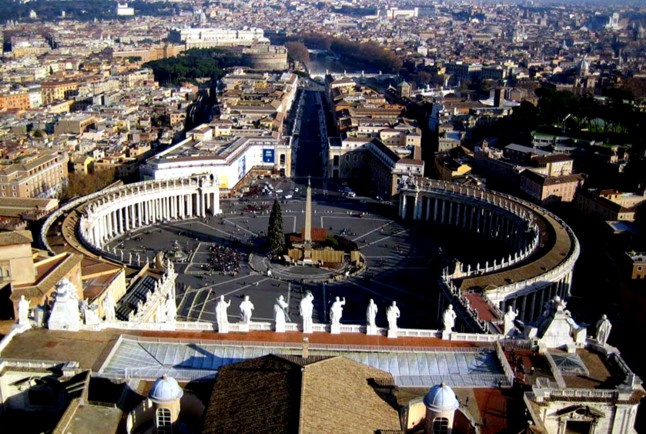
[St Peter’s and the Vatican in foreground; Palace of Justice, large white building in left background]
Understanding Micheli #1: Why He Rejected All Rudy Guede’s Explanations As Fiction
By Brian S
Judge Micheli has had two very important roles. He presided over Rudy Guede’s trial and sentencing, and he presided over the final hearing that committed Raffaele Sollecito and Amanda Knox to trial.
A week ago, just within the three-month deadline, Judge Micheli made public the 106-page report that explains the thinking behind both actions. This is a public document, and in the enviable Italian legitimizing process, the public is encouraged to get and read the report and to understand the full rationales. Excellent analyses have already appeared in Italian in Italy, but no English-speaking sources on the facts of the case have either put the report into English or published more than the most superficial analysis.
These posts will examine several very key areas of the report so that we too may choose whether to buy into the rationales. The translations into English here were by native-Italian speakers and fellow posters Nicki and Catnip. The next post will explain why Micheli ruled out the Lone Wolf Theory, and why he concluded that Knox and Sollecito appeared to be implicated in Meredith’s murder and should therefore be sent to trial.
Judge Micheli maintained that from the moment Meredith’s body was discovered until his arrest in Germany on November 19th, Rudy Guede was in a position to compile a version of his involvement in events at the cottage which would minimise his reponsibilities and point the finger of guilt elsewhere.
He was able to follow the course of the investigation in newspapers and on the internet. He would know of the arrests of Amanda, Raffaele and Patrick. He would know that the investigators had found biological evidence which would sooner or later connect him to the murder, and he would know of other discoveries and evidence which had been publicised in the media.
His story as told in Germany was compiled with all the knowledge about the crime and investigation he would have sought out. On his return to Italy in December he was interviewed by the investigating authorities and gave version 2. He was interviewed again in March which resulted in version 3, and later still made a spontaneous statement to change one or two facts including the admission that the trainer footprint in Meredith’s room could be his. Judge Micheli said:
- Analyzing the narratives of the accused…he is not credible, as I will explain, because his version is (1) unreliable, and (2) continuously varying, whether on basic points or in minor details and outline.
Micheli then examined the details of Rudy’s claimed meeting with Meredith which resulted in his invitation to the cottage on the evening of November 1st.
He noted there were substantial differences between his versions of December and March, particularly with regard to the location of his meeting with Meredith on the night of Halloween and his movements in the early evening of November 1st.
He considered it likely that Rudy had made these changes as he became aware of evidence which contradicted his December version. Notably, in December Rudy claimed to have had his meeting with Meredith which resulted in her invite at a Halloween party given by Spanish students.
By March it was well known that Meredith had spent her entire Halloween in the company of friends, first in the Merlin pub before they later moved on to Domus disco. In March Rudy changed the location of his meeting with her from the Spanish party to Domus, which by chance Rudy had also attended following the party. However, neither Meredith’s friends who were continuously in her company nor those who accompanied Rudy to the Domus witnessed any meeting between the two. Judge Micheli commented:
- On 26 March 2008, instead, Rudy explained to the Prosecution, drawing a picture, that the group invited to the Spaniards’ house actually moved wholus-bolus to the “Domus” club, but it was right in that nightclub that he met Kercher, and not before; offering up a tour-guide description from the chair, saying, “there’s a bar for the drinks and then there’s a room, there’s an arch and a room. I walking [sic] around there, and that’s where I met Meredith”. On the facts of the meeting and the subject of the conversation, he elaborated: “I started talking to Meredith “¦talking anyway I gave her a kiss.. after which I told her how much I liked her and asked her if the next day, in all the confusion anyway, if we were going to meet the next day and she said yes (”¦), we met in the evening around half eight, like that.
While not intending to explore the question, basically irrelevant, of whether the pair had agreed to a more or less specific time (his confirmation of the suggestion of 8.30 pm in both verbal statements however allows the inference that according to Guede they had an appointment), the patent contradiction between the two versions jumps out. One context, of a room between two bathrooms, in an apartment, is completely different to that of a drinks-bar and an arch, in a pub; one might concede, perhaps, the possibility of forgetting which place it was where they last bumped into a friend, but hardly the first time there was a kiss with a girl towards whom one was attracted.
With regard to his movements in the early evening of November 1st, Rudy’s friend Alex failed to corroborate Rudy’s December claim to have visited his flat. He said he didn’t see Rudy either before or after his meeting with Meredith at her cottage.
In March, Rudy changed his story and claimed to have risen at 6pm(following the all-nighter at Domus) before wandering around town for an hour or so. He then said he went to Meredith’s cottage but received no answer so he carried on to Piazza Grimana in the hope he might see people he knew. He thought he arrived in the Piazza at around 7:30pm. He claimed that some time later he left Piazza Grimana and called at the Kebab shop before returning to Meredith’s cottage and arriving some time between 8:30 and 9:00pm.
He said he then waited until her arrival some time just after 9:00pm. It was noted that in both his December and March versions Rudy said he had arranged to meet Meredith at 8:30pm. Micheli noted that this didn’t sit well with another arrangement Rudy had made to meet Carlos (from the Spanish party) between 9:00 and 10:00pm.
Micheli said that neither version of Rudy’s movements could be treated as true because he changed his story to fit facts as they became known and there was absolutely no corroborating witness evidence.
Rudy claimed two situations evolved following his entry with Meredith into the apparently empty cottage:
Whilst he was having a drink of fruit juice from the fridge, he claims Meredith found that 300 euros (her rent money) was missing from her bedside cabinet. Meredith was naturally upset by this discovery and straight away blamed “druggy Amanda”. Rudy said they both checked Amanda’s room to see if the money was there. However, it couldn’t be found and Rudy sought to console her.
He says that this consolation developed into an amorous encounter which proceeded to the stage where “Meredith asked him” if he had a condom. He told he didn’t and since she didn’t either they stopped their lovemaking.
Judge Micheli had a real problem with this story as told by Guede. He found it unlikely that Meredith would be interested in lovemaking so soon following the discovery that her money was missing. He found it unlikely that it was Meredith who was leading the way in this amorous encounter as Rudy was suggesting with his claim that it was “Meredith who asked him” if he had a condom.
Surely, Micheli reasoned, if Rudy was hoping to indulge in a sexual encounter with Meredith following the previous night’s flirting, he would, as any young man of his age, ensure that he arrived with a condom in anticipation of the hoped for liason. But even if he didn’t, and it was true that events had reached the stage where Meredith asked him, then surely given his negative response, Meredith would have again gone into Amanda’s room where, as she had told her friends, condoms were kept by her flat mate. Judge Micheli simply didn’t believe that if they had got to the stage of lovemaking described by Rudy, and following his negative response to her question, they just “STOPPED”. Meredith would have known she had a probable solution just metres away.
Rudy claimed he then told Meredith he had an upset stomach because of the kebab he had eaten earlier. She directed him to the bathroom through the kitchen.
Rudy put on his i-pod and headphones as he claimed was his habit when using the toilet. In his December version Rudy said the music was so loud he heard the doorbell ring but he made no reference to hearing any conversation. A perfect excuse, Judge Micheli says, for not hearing the disturbance or detail of Meredith’s murder. However, in his March version he claims he heard Amanda’s voice in conversation with Meredith. When Rudy did eventually emerge from the bathroom he says he saw a strange man with a knife and then a prone Meredith. Micheli commented:
- ...it is necessary to take as given that, in this case, Kercher did not find anything better to do than to suddenly cross from one moment of tenderness and passion with him to a violent argument with someone else who arrived at that place exactly at the moment in which Rudy was relieving himself in the bathroom. In any case, and above all, that which could have been a surprise to the killers, that is to say his presence in the house, was, on the other hand, certainly not put into dispute:
Meredith, unlike the attackers, knew full well that in the toilet there was a person who she herself allowed in, so for this reason, in the face of someone who had started raising their voice, then holding her by the arms and ending with brandishing a knife and throwing her to the floor, why would she not have reprimanded/reproached/admonished him immediately saying that there was someone in the house who could help her?
“¦Meredith didn’t shout out loudly for Rudy to come and help
“¦There was a progression of violence
“¦The victim sought to fight back
If it is reasonable to think that a lady living 70 metres away could hear only the last and most desperate cry of the girl ““ it’s difficult to admit that Guede’s earphones, at 4-5 metres, would stop him hearing other cries, or the preceding sounds.
Micheli was also mystified as to why Amanda (named in Rudy’s March version) would ring the doorbell. Why wouldn’t she let herself in using her own key? He supposed it was possible Meredith had left her own key in the door which prevented Amanda from using hers, but the girls all knew the lock was broken and they were careful not to leave their own key in the door. Perhaps, Meredith wanted some extra security/privacy against someone returning and had left her key in the lock on purpose. Maybe Amanda was carrying something heavy and her hands weren’t free. Or, maybe, Rudy was just trapped by his December story of the doorbell when he didn’t name anybody and an anonymous ring on the doorbell was plausible.
The judge then took issue with Rudy’s description of events following the stabbing of Meredith. Rudy claimed that when he emerged from the bathroom he discovered a man with a knife standing over Meredith. In the resultant scuffle he suffered cut wounds to his hand. armed himself with chair to protect himself. before the attacker fled when he fell over because his trousers came down around his ankles. Micheli said that those who saw Rudy later that night didn’t notice any wounds to Rudy’s hands although some cuts were photographed by the police when he was later arrested in Germany.
Micheli found Rudy’s claim that the attacker ran from from the house shouting “black man found, black man guilty” unbelievable in the situation. In the panic of the moment it may be conceivable that the attacker could shout “Black man…, run” following the surprise discovery of his presence in the house, but in the situation Rudy describes, blame or expressions of who the culprit thought “the police would find guilty” made no sense. It would be the last thing on an unknown attackers mind as he sought to make good his escape.
Micheli considers the “black man found, black man guilty” statement an invention made up by Rudy to imply a possible discrimination by the authorities and complicate the investigation. Micheli also saw this as an excuse by Rudy to explain away his failure to phone for help (the implication being that a white man could have made the call). It was known by her friends and acquaintances that Meredith was never without her own phone switched on. She kept it so, because her mother was ill and she always wanted to be available for contact should her mother require help when she was on her own
Judge Micheli regarded Rudy’s claimed efforts to help Meredith impossible to believe, given the evidence of Nara Capezzali. Rudy claimed to have made trips back and forth to the bathroom to obtain towels in an attempt to staunch the flow of bood from Meredith’s neck. He claimed to have leaned over her as she attempted to speak and written the letters “AF” on the wall because he couldn’t understand her attempted words. His described activities all took time and Rudy’s flight from the house would have come minutes after the time he alleged the knife-man ran from the cottage.
Nara Capezzali maintained that after she heard Meredith’s scream it was only some seconds (well under a minute) before she heard multiple footsteps running away. Although she looked out of her window and continued to listen for some time because she was so disturbed by the scream, she neither heard nor saw any other person run from the house. That Rudy had run wasn’t in doubt because of his collision on the steps above with the boyfriend of Alessandra Formica. Micheli therefore considered it proven that “all” of Meredith’s attackers, including Rudy, fled at the same time.
Earlier in his report Micheli considered character evidence on Rudy given by witnesses for both prosecution and defense. Although he had been seen with a knife on two occasions, and was considered a bit of a liar who sometimes got drunk, the judge didn’t consider that Rudy had previously shown a propensity for violence, nor behaviour towards girls which differed markedly from that displayed by many other young men of his age.
However, because of the wealth of forensic evidence [on which more later] and his admitted presence in the cottage, combined with his total disbelief in Rudy’s statements, Micheli found Rudy guilty of participation in the murder of Meredth Kercher.
He sentenced him to 30 years in prison and ordered him to pay compensation of E2,000,000 each to Meredith’s parents John and Arline Kercher, E1,500,000 each to Meredith’s brothers John and Lyle Kercher plus E30,000 costs in legal fees/costs + VAT. Also E1,500,000 plus E18,000 in legal fees/costs + VAT to Meredith’s sister, Stephanie Kercher.
Understanding Micheli #2: Why Judge Micheli Rejected The Lone-Wolf Theory
By Brian S
And so decided that Raffaele Sollecito and Amanda Knox should face trial.
First, just to recap: Judge Micheli presided over both Rudy Guede’s trial and sentencing to 30 years and the final hearing that committed the two present defendants to trial.
Ten days ago, Judge Micheli made public the 106-page report that explains the thinking behind both actions. This is a public document, and in the enviable Italian legitimizing process, the public is encouraged to get and read the report and to understand the full rationales. Excellent analyses have already appeared in Italian in Italy, but no English-speaking sources on the facts of the case have either put the report into English or published more than the most superficial analysis.
These posts are examining several very key areas of the report so that we too may choose whether to buy into the rationales. The translations into English used here were by native-Italian speakers and fellow posters Nicki and Catnip.
Right at the outset of his Sentence Report on the conviction of Rudy Guede, Judge Micheli stated that it was neither the place nor his intention to make the case against either Raffaele Sollecito or Amanda Knox. He said he must necessarily involve them to the extent that they were present at the discovery of Meredith’s body. He said he must also examine evidence against them where he saw it as indicating that Rudy Guede was not a lone wolf killer and implicated them as his possible accomplices in Meredith’s murder.
Judge Micheli described the sequence of events laid out by the prosecution which lead to the discovery of Meredith’s body:
Early on the morning of November 2nd, Signora Lana Biscarini received a bomb threat call made to her home at 5A Via Sperandio. (This later transpired to be a hoax.)
Some time later Signora Biscarini found a mobile phone in her garden. She “had heard” that bombs could be concealed in mobile phones and so she took it to the police station arriving at 10:58am as recorded by ISP. Bartolozzi
The postal police examined the phone and following removal of the SIM card, discovered at 11:38am that it belonged to a Filomena Romanelli who lived at the cottage at 7 Via della Pergola. Following a call by Signora Biscarini to check with her daughter who was still at home, it is in the record at 11:50am that neither say they know the Filomena in question. At around noon Signora Biscarini’s daughter rings her mother at the police station to say she has found a second phone.
The second phone (Meredith’s) is collected from Via Sperandio and taken to the police station. Its receipt there is logged by ISP. Bartolozzi at 12:46pm. During its examination Meredith’s phone is also logged as connecting to the cell of Strada Borghetto di Prepo, which covers the police station, at 13:00pm. At 13:50pm both phones, which have never left the police station following their finding, are officially seized. This seizure is entered in the log at 14:00pm.
Separately, as part of the bomb hoax investigation, agents of the postal police are dispatched to make enquiries at Filomena’s address in Via della Pergola.
They are recorded in the log and filmed on the car park camera as arriving at 12:35pm. They were not in possession of Filomena’s phone, which remained at the police station, nor of Meredith’s which at this time was being taken from Via Sperandio to the police station for examination as part of the bomb hoax enquiry.
Judge Micheli said that some confusion was created by the evidence of Luca Altieri (Filomena’s boyfriend) who said he saw two mobile phones on the table at the cottage. But, Micheli said, these two phones either belonged to the others who arrived, the postal police themselves or Amanda and Raffaele. They were NOT the phones of Filomena or Meredith.
On their arrival at the cottage, the agents of the postal police found Raffaele Sollecito and Amanda Knox standing outside the front door.
The two seemed surprised to see them (the postal police had come to talk to Filomena about a bomb hoax which potentially involved her phone, plus they had recently been informed of the discovery of second phone in the same garden), but then they explained they had discovered suspicious circumstances inside the cottage.
Raffaele said he had already phoned the police and they were awaiting their arrival in connection with that. Elsewhere in his report Micheli points out that Raffaele did, in fact, make a call to his sister at 12:50pm, followed by two calls to “112” reporting a possible burglary at 12:51 and 12:54pm, 15 minutes after the arrival of the postal agents.
Judge Micheli said the postal police were shown into the cottage by Raffaele and Amanda. They pointed out the traces of blood around the apartment, the state of the toilet and the disturbance to Filomena’s room. They said they didn’t think anything had been taken. They pointed out that Meredith’s door appeared to be locked, Raffaele said he had tried to open it, but Amanda said Meredith used to lock the door even when she was going to the bathroom to shower.
Shortly afterwards Luca Altieri and Marco Zaroli arrived. Luca said he had just been contacted by his girlfriend Filomena, who in turn had just been contacted by Amanda Knox about the possible break in. A few minutes later, Filomena herself arrived with Paola Grande. Micheli noted that Filomena had immediately contradicted what Amanda had told the postal police and she said that Meredith never locked her door. She also told the postal police that the phone found with a SIM card in her name was in fact Meredith’s 2nd phone, that she had given Meredith the SIM as a present. The postal police said that they didn’t have the authority to damage property and so the decision was made that Luca would break down the door.
This he did. The scene when the door flew open was instantly obvious, blood everywhere and a body on the floor, hidden under a duvet except for a foot and the top of Meredith’s head. At that point ISP Battistelli instantly took charge. He closed the door and forbade anyone to enter the room before contacting HQ.
Following his description of the events which lead to the discovery of Meredith’s body, Micheli then dedicates quite a few pages of his report to detailing the exact locations, positions, descriptions and measurements of all the items, blood stains, pools and spots etc.etc. found in her room when the investigators arrived. He also goes into precise details on the injuries, marks, cuts and bruises etc. which were found by Lalli when he examined Meredith’s body in situ at the cottage before she was moved. Despite their extent, it is obvious these details are only a summary of the initial police report and also a report made by Lalli on the 2nd November.
It is these details which allowed the prosecution to lay out their scenario for the events which they say must have happened in the room. It is also these details which convince Micheli that it was impossible for this crime to be carried out by a single person. In his report, he dismisses completely the scenarios presented by the defences of Amanda and Raffaele for a “lone wolf killing”. Micheli says that he is convinced that Meredith was sexually assaulted and then murdered by multiple attackers.
Judge Micheli also explains in his report how the law will decide on sexual assault or rape where the medical report (as was Lalli’s) is somewhat inconclusive. Else there would be no point in a woman reporting rape unless she had serious internal injuries. His conclusion: Meredith was raped by Rudy Guede manually.
So why does Judge Micheli believe that Amanda Knox and Raffaele Sollicto were possible accomplices of Rudy Guede and should be tried for the murder of Meredith Kercher?
In his report, he doesn’t look at the evidence which involves just them, nor does he analyze their various stories in his report. He doesn’t look at events involving them which occurred between the 2nd and 5th November. He does note a few items here and there, but these aren’t given as the major reasons for his decision to indict them.
He notes Raffaele’s apparent lies about the time he made the 112 phone calls. He dismisses Raffaele’s defense claim that the disposal of Meredith’s phones didn’t allow time for Raffaele to get to the cottage after watching his film, kill Meredith, and then dispose of the phones in Via Sperandio before the aborted call to Meredith’s bank. He noted that the cell which picked up the brief 10:13 call to Meredith’s bank also picked up most of Meredith’s calls home.
He asked whether it was possible for anybody to believe that each time Meredith wanted to phone home, she walked down to Via Sperandio to make the call. He notes that the police found Amanda and Raffaele’s behaviour suspicious almost straight away. He notes that Filomena said that the relationship between Amanda and Meredith had deteriorated by October. He says he doesn’t believe at all that cannabis caused any loss of Amanda’s and Raffaele’s memories.
Judge Micheli says he bases his decision on the following points of evidence:
[Note: The following paragraph numbers form no part of Micheli’s report. They are used in the context of this summary to identify the points of evidence contained in his report which will be examined and summarised in greater detail in follow-up posts]
1) Judge Micheli, after hearing both prosecution and defense arguments about Meredith’s and Amanda’s DNA on the knife and Raffaele’s DNA on Meredith’s bra clasp, accepted the prosecution argument that that both were valid evidence. He did note, however, that he fully expected that the same argument would be heard again at the full trial. In his report, Micheli dedicates several pages to explaining the opposing arguments and how he made his decision to allow the evidence. It is a detailed technical argument, and it is not proposed to examine it any closer in this post.
2) Judge Micheli explains that blood evidence proves that Meredith was wearing her bra when she was killed. Nor is it just the blood on her bra which demonstrates this. It’s also where the blood isn’t on her body. He says that Meredith was wearing her bra normally when she laid in the position in which she died, and she was still wearing it for quite some time after she was dead. Her bra strap marks and the position of her shoulder are imprinted in the pool of blood in that position. Meredith’s shoulder also shows the signs that she lay in that position for quite some time.
He asks the question: Who came back, cut off Meredith’s bra and moved her body some time later? It wasn’t Rudy Guede. He went home, cleaned himself up and went out on the town with his friends. Judge Micheli reasons in his report that it could only have been done by someone who knew about Meredith’s death and had an interest in arranging the scene in Meredith’s room. Seemingly who else but Amanda Knox?
She was apparently the only person in Perugia that night who could gain entry to the cottage. And the clasp which was cut with a knife when Meredith’s bra was removed was found on November 2nd when Meredith’s body was moved by the investigators. It was right under the pillow which was placed under Meredith when she was moved by someone from the position in which she died. On that clasp and its inch of fabric is the DNA of Raffaele Sollecito and Amanda Knox. Micheli reasons in his report that Raffaele and Amanda seemed to have returned to the cottage some time after Meredith was dead, cut off her bra, moved her body, and staged the scene in Meredith’s room.
3) Judge Micheli explains his reasoning on the method of Rudy’s entry into the cottage. He says that Rudy’s entry through the window is a very unlikely scenario and the evidence also indicates otherwise. He says the height and position of the window would expose any climber to the full glare of traffic headlights from cars on Via della Pergola. He asks, why wouldn’t a thief choose to break in through a ground floor window of the empty house? He says the broken glass and marks on the shutter both demonstrate the window was broken from the inside, some of the glass even falling on top of Filomena’s clothes which had been thrown around the room to simulate a robbery.
But his major reasoning for believing Rudy’s entry was through the front door are the bloody bare footprints which show up with luminol and fit Knox’s and Sollecito’s feet. These suggest that they entered Filomena’s room and created the scene in there after Meredith was killed. Allessandra Formica witnessed Rudy run away shortly after Meredith was stabbed. Someone went back later, left those footprints and staged the scene.
This, when considered in combination with the knowledge that person demonstrated of Rudy’s biological involvement with Meredith when they also staged the sex assault scene in Meredith’s own room indicates that that person was present when Meredith was assaulted and killed. He said it also demonstrated an attempt by someone who had an interest in altering the evidence in the house to leave the blame at Rudy’s door. Micheli reasoned, the only person who could have witnessed Rudy’s earlier sex assault on Meredith, could gain entry via the door and had an interest in altering the crime scene in the house appeared to be Amanda Knox. In his report, Micheli states that this logic leads him to believe that Amanda Knox was the one who let Rudy Guede into the cottage through the front door.
4) Judge Micheli examines the evidence of Antonio Curatolo. He says that although Curatolo mixes up his dates in his statement, he does have a fix on the night he saw Amanda and Raffaele in Piazza Grimana sometime around 11:00 to 11:30pm. Curatolo is certain it was the night before the Piazza filled up with policemen asking if anyone had seen Meredith. In his evidence, he says they came into the square from the direction of Via Pinturicchio and kept looking towards the cottage at Via della Pergola from a position in the square where they could see the entrance gate.
Judge Micheli reasons in his report that their arrival from Via Pinturicchio ties in with the evidence from Nara Capazzali that she heard someone run up the stairs in the direction of that street. He also reasons that they were likely watching the cottage to see if Meredith’s scream had resulted in the arrival of the police or other activity.
5) Judge Micheli examines the evidence of Hekuran Kokomani and finds him far from discredited. His says the testimony is garbled, his dates and times makes no sense but…. that Hekuran Kokomani was in the vicinity of the cottage on both 31st Oct. and 1st Nov isn’t in doubt. Furthermore, Micheli says that when he gave his statement, the details which he gave of the breakdown of the car, the tow truck and the people involved weren’t known by anyone else. He must have witnessed the breakdown in Via della Pergola. The same breakdown was also seen by Allessandra Formica shortly after Rudy Guede collided with her boyfriend.
This places Hekuran Kokomani outside the cottage right around the time of Meredith’s murder and he in turn places Raffaele Sollecito, Amanda Knox and Rudy Guede together outside the cottage at the same time. His evidence also places all three outside the cottage at some time the previous night.
Judge Michelii found that all this evidence implicated Amanda Knox and Raffaele Sollecito as accomplices of Rudy Guede in the murder of Meredith Kercher.
Understanding Micheli #3: How Damning Is The DNA Evidence Coming Up?
By Nicki
Probable answer? Pretty damning.
Judge Micheli has had two very important roles. He presided over Rudy Guede’s trial and sentencing, and he presided over the final hearing that committed Raffaele Sollecito and Amanda Knox to trial.
Late January, Judge Micheli made public the 106-page report that explains the thinking behind both actions. These posts are examining several very key areas of the report so that we too may choose whether to buy into the rationales.
The trial to establish the truth about the murder of Meredith continues next Friday. As we’ve reported, various human witnesses have already been heard from: the Postal Police who discovered Meredith’s body, Meredith’s two Italian roommates, and her seven British friends.
Coming up soon is a more silent witness, one very important to both the prosecution and the two defenses: the DNA evidence.
Specifically the DNA belonging to Meredith, Knox, Sollecito, and Guede which was found at the scene of the crime, and on the suspected murder weapon found, apparently hidden, in Raffaele Sollecito’s house.
Traces of Meredith’s DNA have been found on a knife compatible with the wounds that caused her death. Amanda Knox “˜s genetic material was identified on the knife handle. DNA belonging to Sollecito has been found on the clasp of the victim’s bra. And more DNA showing Rudy Guede’s genetic profile was found on the victim’s body and elsewhere in the house.
In summary, the biological sources and locations where DNA belonging to the three defendants was found are these:
- Guede’s DNA (from epithelial cells) was found inside Meredith, on toilet paper, on the right side of Meredith’s bra, mixed with Meredith’s DNA on the her purse zip, and on the left cuff of Meredith’s light blue sweater
- Sollecito’s DNA (from epithelial cells) was found on Meredith’s bra clasp, mixed with Meredith’s DNA, and on one cigarette butt found in the kitchen
- Knox’s DNA (from epithelial cells) was found on the knife sheath, and close to the blade junction. It was not possible to ascertain both the haematic and epithelial source of Meredith’s DNA on the knife blade, due to the scarcity of the sample. But Judge Micheli noted that reasonable doubt persist that blood could have been present also.
- Other significant biological traces belonging to Meredith - for example, DNA originating from the blood-trace footprints revealed by luminol found in Filomena’s bedroom, as already reported at trial.
Claims of contamination and “poor matches” of the DNA samples were raised by the Sollecito and Knox defenses, although not by Guede’s. The DNA expert Dr. Stefanoni’s arguments in reply to the defenses’ claims are summarized in Judge Micheli”˜s report.
Dr Stefanoni reported that the locus ascribable to Meredith and identified on the knife blade shows readings of 41 and 28 RFU. Conventionally, RFU values lower than 50 can be defined as low. But she maintained that the profile matched Meredith’s by explaining that there is no immediate correlation between the height of the peaks obtained by electropherogram and expressed in RFU, and the reliability of the biological investigation.
In fact “even if statistically - in most cases - the RFU data is directly proportional to the possibility of a certain interpretation of the analysis result, on the other side many cases of high peaks of difficult interpretation exist (because of background noises), as well as low peaks that are objectively unquestionable, hence the need to proceed to the examination of data that is apparently scarce, but that mustn’t be considered unreliable per se.”
*The use of multiplex PCR and fluorescent dye technology in the automated detection and analysis of short tandem repeat loci provides not only qualitative information about the profile - i.e. which alleles are present - but can provide also quantitative information on the relative intensities of the bands, and is therefore a measure of the amount of amplified DNA.”
So if on one side Dr Stefanoni admits that the RFU readings are low, on the other her experience suggests that many cases of unquestionable matches exist showing readings lower than 50 RFU, and this appears to be the case with Meredith’s DNA sample on the knife.
Contamination in the laboratory is categorically excluded by Dr Stefanoni. The samples were processed with maximum care in order to avoid any contamination during lab procedures. Contamination during the collection phase is excluded by Judge Micheli, as the samples were collected by different officers at different times in different places (example Via della Pergola at 9:40am on Nov 6. 2007, and Sollecito’s apartment at 10:00am, on the same day, by a different ILE team).
As for Sollecito’s DNA found on the bra clasp, the match is unquestionable, according to the lab reports. Samples from crime scenes very often contain genetic material from more than one person (e.g. Rudy Guede’s DNA has been identified in a mixture with the victim’s DNA in a few places), and well-known recommendations and protocols exist in order to de-convolute mixed samples into single genetic profiles.
So if the lab reports indicate that unquestionable biological evidence of Sollecito’s DNA was found on the bra clasp, at the present time we have no reason to believe that these recommendations weren’t followed and that therefore the reports are not to be trusted.
As to cells “flying around” depositing themselves ““ and their DNA content - here and there around the murder scene, there have been some imaginative theories advanced, to say the least.
The reality though is that although epithelial cells do shed, they don’t sprout little wings to flock to one precise spot, nor grow feet to crawl and concentrate on a piece of evidence. There needs to be some kind of pressure on a surface in order to deposit the amount of biological material necessary to yield a reliable PCR analysis result. A simple brushing will not do.
As a matter of fact, Dr Stefanoni agreed with Guede’s defense that Guede”˜s genetic material found on the left sleeve of Meredith’s blouse was minimal; and this was because the DNA found there belonged to the victim and was not a mixture. In the situation where there is a clear disproportion between quantitative data of two DNA’s coexisting in a biological trace, the PCR will amplify the most abundant DNA.
As agreed by Dr. Stefanoni and Guede’s defense, the conclusion here was that on the left sleeve there was plenty of Meredith’s DNA but very little of Guede’s. (This was used by his defense to deny that Guede had exerted violence on Meredith’s wrist).
After listening to the arguments of the prosecution and the defenses, Judge Micheli provided reasons why he rejected the contamination claims and ruled that all the biological traces identified as reflecting Sollecito’s and Knox’s DNA are admissible as evidence. He arrived at the conclusion that the DNA evidence is sound and, considered along with the non-biological proof, he decided there was more than enough evidence to order Knox and Sollecito to stand trial.
Regarding the biological significance of the traces, we are now looking forward to hearing the Knox and Sollecito defenses’ counter-arguments. But as we understand it now, the DNA evidence for the trio having all been involved in the murder seems pretty damning.
Understanding Micheli #4: The Staged Scene - Who Returned To Move Meredith?
By Brian S
Please be warned that this is sad and hard-going, although many other passages from the Micheli report we will never post on here are even more harrowing.
Just to recap. Judge Micheli presided over Rudy Guede’s trial and sentencing and the final hearing that committed Raffaele Sollecito and Amanda Knox to trial.
Late January he made public the 106-page report that explains the thinking behind both actions. These posts are examining key areas of the report so that we too may decide on the rationales.
This post is about the final position of the body. Why this matters so much is that if the evidence holds firm, all by itself it will prove that there was a major rearrangement of the crime scene, to try to throw investigators off the trail.
This is as near to an 80,000 pound gorilla in the room as we are likely to see in this trial. And it may even be on the trial agenda for this coming Friday and Saturday.
Reports by the crime-scene investigators and Dr Lalli are summarised in Judge Micheli’s report. They describe the detail of the scene discovered in Meredith’s room. The investigators measured and photographed the position and state of everything, including blood, as it was in the room before anything was moved.
Amongst the items noted was a white bra. Some parts were soaked in blood, particularly the right shoulder strap and the outside of the left cup. They also noted that a portion of the backstrap with its clasp fixings was missing. Meredith herself was lying on her back midway between the wardrobe and the bed, without her jeans, a pillow under her buttocks and her top rolled up to reveal her chest.
Following this survey, Meredith’s body was then turned and moved by the investigators. This revealed the other items on which her body had lain. A tennis shoe, a white sheet from the bed and a blue zipped top, all with blood stains. Also a green bath towel and an ivory bath towel, both soaked in blood, and underneath the pillow was the missing clasp section of the bra back-strap.
Judge Micheli notes that Amanda’s defence claimed that “the small round spots of blood” apparent on Meredith’s chest indicated that she was not wearing her bra when she was killed. He agreed that it was likely that these spots fell from Meredith’s gasps for breath as she lay on her back after she had been stabbed. However, he could not agree with their conclusion that her bra had been removed before this time, as similar small round spots were also found on Meredith’s bra.
Micheli reasoned that this indicated that Meredith was still wearing her bra as she gasped for breath, but that her top was rolled up and the bra moved also. Thus indicating the sexual nature of the original attack, but also allowing the small round spots to fall on both chest and bra. Furthermore, other blood evidence involving the bra indicated that it wasn’t removed until some time after Meredith had died.
He said that Meredith’s bra was found by investigators away from other possible blood contamination on the floor, near to her feet. Photographs of Meredith’s body show clear white areas where the bra prevented blood from falling onto Merediths body. These white areas corresponded to those areas where blood was found on her bra. This was particularly true in the area of the right shoulder strap which was soaked from the wound to Meredith’s neck.
Micheli said that evidence showed that Meredith had lain on one shoulder near the wardrobe. She lay in that position long enough for the imprint of her shoulder and bra strap to remain fixed in the pool of blood after she was moved to the position in which her body was finally found. Photographs of blood on her shoulder matched the imprint by the wardrobe and her shoulder itself also showed signs that she had remained in that position for some time.
Based on all this, Judge Micheli concluded that there could be no doubt that Meredith’s body was moved away from the wardrobe and her bra removed quite some time after her death.
Neighbor Nara Capezzali had testified that people fled from the cottage within a minute of Meredith’s final scream. There was no time for any alteration of the crime scene in those very few moments.
Judge Micheli asks in his report, who could have returned later and staged the scene which was found? Who later moved Meredith’s body and cut off her bra? He reasons it could only be someone who had an interest in changing what would become a crime scene found at the cottage. Who else but someone who lived there, and who wanted to mislead the coming investigation?
It couldn’t have been Laura, she was in Rome. It couldn’t have been Filomena, she was staying with her boyfriend. It was very unlikely that it was Rudy Guede, all proofs of his presence were left untouched.
The culprits ran from the cottage in different directions and there is no reason to believe they met up again before some or one of them returned. Judge Micheli stated that, in his opinion, this just left Knox who would seem to have an interest in arranging the scene the police would find.
Bloody footprints made visible with luminol in Filomena’s room contain Meredith’s DNA. This indicated to Judge Micheli that the scene in Filomena’s room was also staged after Meredith was killed.
In Micheli’s opinion the scene in Meredith’s room was probably staged to point the finger at Rudy Guede. All evidence related to him was left untouched, and the pillow with a partial palm print was found under Meredith’s repositioned body.
But whoever later arranged that scene in Meredith’s room also unwittingly indicated their own presence at the original sexual assault. Who else could have known that by staging an obvious rape scene, they would inevitably point the investigators towards Rudy’s DNA which they knew could be found in Meredith?
Micheli asks: Seemingly, who else could it have been but Amanda Knox? And this in part is why she was committed to trial, for her defense to contend this evidence.
Saturday, December 18, 2010
First Reports On Scope Of Appeal Sounds Like Maybe A Setback For The Defenses
Posted by Peter Quennell
The first full reports are not out yet. This is a first quick take on the Italian reporting and may be subject to correction.
Some of the Cassation’s hard-line decision for rejecting Rudy Guede ‘s 10 appeal grounds in Rome on thursday will indeed be accepted into this appeal for the judges’ consideration.
The judges are agreeing to the defense request for a review of the testing of the DNA on the bra clasp and the large knife, though of course nobody - nobody - so far has ever proved contamination as the prosecutors today pointed out.
Two Rome experts in DNA have already been nominated.
Apparently none of the other very extensive forensic evidence at the scene of the crime - which is the entire apartment, not merely Meredith’s bedroom - is to be retested. That has always been very tough to explain away.
Apparently only one or two of the previous witnesses whose testimony is described in the Massei report will be heard from again. Possible Guede confidant Alessi will be allowed and maybe Aviello who claimed his missing brother really did it.
And apparently ninety days is added to the allowed duration of this appeal, because the Massei Report took 90 days to produce. The deadline now is next September, although if it lasts through to the spring we will be surprised.
The defense doesn’t seem to have many strong hopes going forward. No more Spiderman attempts on Filomena’s window. They found no room for appeal with regard to the various contradictory alibis, the various peculiar phone calls, and assorted bizarre behaviors.
Remember that even Knox and Sollecito themselves have claimed they were zonked out of their skulls on the night - though magically they seem to have managed a major cleanup and rearrangement of the entire crime scene, minus evidence pointing to Guede.
The astute commenter Piktor posted this on PMF
The expert review would be needed if the scientific results were the only evidence that convicts.
What if the DNA evidence was thrown out. Could you convict without it?
You have the staging, the lies, the false accusation, the police testimony, the defendant’s multiple alibis that don’t mesh, Mrs. Mellas testimony in court exposing Knox’s willful “confusion”, the email and diaries.
You add it up and it all points in one direction. No doubt about the result.
The prosecution narrative makes sense. The defence has no narrative.
Monday, November 29, 2010
Explaining The Massei Report: The Timeline For Events Before, During, And After The Night #1
Posted by catnip
The Masssei Timeline To Midnight 1 Nov
These two posts list all of the events precisely timed in the Massei Report. Page numbers shown in brackets are those in the original Italian version.
This timeline will be reposted over on the TJMK Massei Report summaries and highlights page as we populate that page further starting this week.
There are plenty of mentions of imprecise occasions and general time periods, such as when Rudy told Giorgio Cocciaretto about liking Amanda (p26) or when lawyer Palazzoli found out their stolen computer had been recovered in Milan (p33), but they are not listed here.
nts_before_during_2/”>Post #2
Please click here for more
Explaining The Massei Report: The Timeline For Events Before, During, And After The Night #2
Posted by catnip
The Masssei Timeline After Midnight 1 Nov
We continue here from Post #1 These two posts list all of the events precisely timed in the Massei Report. Page numbers shown in brackets are those in the original Italian version.
There are plenty of mentions of imprecise occasions and general time periods, such as when Rudy told Giorgio Cocciaretto about liking Amanda (p26) or when lawyer Palazzoli found out their stolen computer had been recovered in Milan (p33), but they are not listed here.
Please click here for more
Tuesday, May 25, 2010
The Chilling Killing Propensities Of Sollecito’s Various Knives
Posted by SomeAlibi
The few rather puerile websites trying to make the case that Knox and Sollecito were framed all have this one thing in common.
They are all of them a mile or more wide on the facts of the evidence - but only a millimeter or so deep.
Time and again on some point of evidence TJMK and PMF have gone far, far deeper than they have - and from then on, on that particular point, deafening silence is quite usual. Here is one very good example, on TJMK, highly incriminating in itself, and highly suggestive of when and how Edda Mellas first realised her daughter was guilty.
On that point of hard evidence, almost enough to incriminate Amanda all by itself, there has never been any real comeback. The PR campaign’s Wizard of Oz moves on.
Now we advance another in-depth analysis. This time it focuses on the really deadly nature of Sollecito’s various knives, and we’ll await the comeback if any with interest.
In effect, the deniers’ argument made is that Sollecito is not a collector or an aficionado, just a young man who might need to cut an apple with a pocket-knife. And he’s certainly not a hardcore knife collector, collecting fantasy-wish-list knives.
Carrying a pocket-knife above a certain size in public is illegal in Italy. But ignoring that technicality for a minute, let’s examine the knives of Raffaele Sollecito which were impounded during his arrest. Three knives, moving up in degrees of interest, not counting the very large knife prosecution witnesses identified as the murder weapon.
Knife Three
Take a look at the image up the top here. This knife actually hung above Sollecito’s bed.
It is a replica combat knife. The heavy t-bar protection is designed to protect the hand of the knife-user from slipping onto the blade when being used to stab another person, as well as to protect the user against another blade.
Blood grooves exist for only one purpose - as they imply, they are there for when one stabs someone deeply with the knife: they allow the blood to run out down the grooves. This breaks the seal and suction of the enclosing wound around the blade which makes the knife far easier to withdraw
That knife is specifically designed for stabbing people as well as cutting sentries’ throats etc. The female arm in the picture is Amanda’s by the way (you can find the zoomed-out version showing all of Amanda in the PMF gallery), as it was taken when she was being shown the knife in court.
She must have recognized it, of course, since it was from Raffaele’s bedroom, and would have been a rather noticeable discussion piece within view whenever Knox was in the room or laying on the bed.
Many teenagers and young adults put the objects of their highest interest and infatuation, from bands to film-stars, on their walls. Raffaele chose to put a knife designed for killing people on his wall.
It would be a lurking and incongruous presence on a small student-sized bedroom wall in the minds of the vast majority of people. The question of Raffaele’s degree of attraction to knives such that he actively chose to mount a replica combat knife on his bedroom wall doesn’t appear to need much further discussion.
And yet, it’s actually only less than a third of the equation as it was only a replica. Now let’s turn to two real knives - his so-proclaimed pocket knives - which Raffaele confirmed in his own words that he carried on him every day for years, and which tell a more subtle and deeper story.
First, consider what is the meaning of a pocket knife to you.
The phrase “˜pocket knife’ has been translated from the Italian from the transcripts / press coverage. For many, including myself, this will have conjured a mental image of a Swiss Army type knife or a simple blade and indeed this is the prevalent definition of a conventional pocket knife.
Let’s actually have a look at Raffaele’s “pocket knives” courtesy of pictures posted by poster Jools on PMF. These knives were impounded, one from the apartment and one, unbelievably, from Raffaele’s person at the Questura.
In the case of the latter, even Raffaele saw this as a devastating “own-goal” as we can read from his diary entry of 7 November 2007; “I’m not even able to offer guilt, given my deep fu**ing stupidity for the fact that I smoke cannabis I even forget what I have eaten and also for that I carry behind a knife to nock the tables and the trees and I carry it so often that I brought it also to the police headquarters.”
Knife Two
This is a 2.9 inch blade drop point, near spear point knife. At first glance (apart from the mark on the clip which should be ignored and was benign), the deniers camp might say “Well, look at it - it’s just a pocket knife even if it looks a bit sharp and so on ““ look, it’s even got a cute clip for the pocket, like on a pen.”
Let’s start there. The clip is actually a reversible one ““ it can be taken off and re-screwed to the knife to the user’s side / orientation of preference. This is already a proper knife rather than a cheap shop pick-up.
More obviously, the half-serrated edge to the blade for cutting is an active design (and purchase) feature.
Third, the “˜grind’ on the top the blade shows an aesthetic sensibility to the design but also serves a functional purpose for a cutting or stabbing use in terms of reducing friction.
Fourth, the serrations or (quite aggressive) “˜jimping’ on the top of the handle, just behind the blade are there to provide thumb grip.
Quite a lot of design features on this knife for a casual “pocket knife” one might think.
Which leaves us with the odd bar code thing at the top edge of the blade and the indistinct logo on the blade. Let’s see what that logo is with a little enhancing;
“˜Brian Tighe Design’. Brian Tighe?? Google sets us straight on who he is.
“You’d need a calculator to count the number of custom knife-makers who have jumped into the tactical fray over the past five years. You can tally the cream of the crop on two hands, being sure to earmark one of those digits for knifemaker Brian Tighe. In a matter of just a couple of years Tighe (pronounced “Tie”) has risen from the rank and file of edged weapons artisans to the rarefied air of the top 10 elite.”
A look at Tighe’s site shows that his own company’s knives sell for 500 dollars and up. He is a globally feted knife designer whose wait list for his knives was as high as seven years at one point.
So the design of the knife here is actually that of a noted master knife maker. Almost something one might collect, one might say. As loaded as Papa Doc Sollecito is, did Raffaele really spend over 500 dollars on such a knife?
Well no, actually, he didnt need to. This is a Columbia River Knife & Tool produced 811x series knife bearing Brian Tighe’s name. CRKT are a dedicated knife company who specialise in working with the world’s leading knife designers and producing the knives for a bigger market but still as proper aficionado pieces.
At this level of knife, there are extensive magazine, web and “˜user’ reviews. Knives like this are tested for resilience and sharpness including things like edge-on paper-cut tests where paper is cut through just like a razor from the side of a piece of paper held by one hand.
Such a knife is able to catch the edge of the paper and then slice straight through the width of the paper side-on without any tension in the paper. That’s what a knife like this is capable of. A “pocket knife” to me sounds like something picked up for 10 or 20 euro. The current model that replaced Raffaele’s now out-of-series model sells for about $80 at retail. Here’s the actual 2004 model that Raffaele had i.e. the same as the one above;
Worth looking at that for a second or two… Oh the bar code? It’s not a bar code, it a rectangular thumb stud you flick the knife open with. When you do, the knife goes to a locked position unlike many “pocket-knives”. In English speaking knife circles, these knives are not generally referred to as pocket-knives but are called “Tactical Knives” which are a cross-over of usage knives for outdoors / cutting etc but also for personal “protection”.
So, in addition to the wall-mounted replica combat knife, one of Raffaele’s daily carries (see diary / testimony) was a designer thumb-flicked locking tactical knife with jimping, top blade grind, switchable clip and a razor sharp edge costing about 80 bucks. That you can only carry in your pocket. Illegally. Some apple-cutter.
Let’s take a look now at the most worrying knife of all…
Knife One
At first glimpse, this “pocket knife” looks quite martial arts like, given the hole and the weird top edge of the blade and the spider logo.
The logo marks this as a Spyderco knife ““ a large premium knife manufacturer of tactical and many other types of knives. This particular model is a Delica4 Emerson Opener retailing for about $109.95rrp. Of particular note about this knife is the hole and the top edge. The hole, a Spyderco feature, allows a thumb to flick the blade open very quickly. This knife is about speed.
But actually the thumb hole is not the real speed feature ““ that is reserved for the top edge curl.
This is a truly specialist feature known as an Emerson Opener or “wave”. The idea is that the curl in metal catches on the edge of a pocket edge on drawing the knife and opens it immediately (see videos below).
This is a speciality feature licensed from Emerson knives ““ Emerson being another feted “˜name’ knife designer. The wave is only present on two of Spyderco’s 330 knives listed on their website ““ the Delica and the ¾ inch larger sister knife the Endura (“the best self defence knife in the world” according to one enthusiastic teenager on youtube). That’s how specialist it is.
The job of the wave feature is to provide the fastest opening knife in the world bar none ““ faster than a flick or spring knife in fact. This video (many similar to be found) gives a rather disturbing insight into what the real attraction of owning this knife is to a hardcore knife knut like Raffaele; (remember when you watch this for the first time that the knife is closed inside that pocket and also enable the sound on the embedded player below by clicking off the mute)
If I thought my son had a penknife, but then actually saw him with this, we would be having a very long chat..
“Enough!” the deniers say?! “You’ve still got it in for Raffaele haven’t you?” they say?! Despite the replica combat knife on the bedroom wall, the designer Brian Tighe Design CRKT drop-point and the Spyderco Delica4 with wave design)? “You’ve used prejudicial phrases like “hardcore knife knut” haven’t you?” they say?!
Sorry, but don’t look at me. They’re not my words.
They’re the words of Spyderco itself on its own webpage. See here and below.
Raffaele was out to impress Amanda and by his own admission both obsessive about her and a hardcore stoner. He also thought knives - proper knives with exclusive features by name knife designers not pocket knives were fascinating.
As with all of this case and any case, you REALLY need to look at the detailed evidence.
The overwhelming prevalence of skin-deep level of analysis / downplaying of this case by much of the deniers camp will lend and always has lent itself to people dismissing serious evidence as inconsequential based on their lack of understanding of what actually is in question.
The “mere pocket-knife” impression of Raffaele’s interest in knives is a clear case in hand. Raffaele’s father testified in court that his son carried a pen-knife. Some pen-knives or pocket-knives these really were…
As always with this case, when you take the time to look at the real detail, the reality you find is something far more disturbing…..
Sunday, February 28, 2010
This Was Definitely Not A Close Or Indecisive Case - Reasonable Doubt Was In Fact Totally Eliminated
Posted by FinnMacCool
Trashing Of Hard Evidence Gets Worse
You can see from the posts directly below that the Knox-was-framed camp is, if anything, becoming more superficial with all those pesky facts rather than less.
Hard reality is that nobody has ever come within light-years of constructing an alternative scenario of the crime. Hard reality is that for Knox and Sollecito the totality of the facts, seen together as the judges and jury did, are extremely damning. Hard reality is that the verdicts were decisive and unanimous. And hard reality is that Judges Sentencing Report due out some time this week will apparently be quite definitive.
Please click here for more
Wednesday, February 24, 2010
Oprah Gets Snowed: Why Was She Not Made Aware of The Race Card Being Played?
Posted by Peter Quennell

Previous posts on Oprah’s intervention here and here.
We will have a detailed takedown of the large number of disputable claims made today on Oprah Winfrey’s show posted here in a day or two.
Meanwhile, we must say that it was a pretty weird experience to witness Oprah Winfrey, of all people, being taken in by the “of course the black guy did it” meme.
- Is she aware that the poor black guy Rudy Guede has no prior convictions and that all three have had prior brushes with the police?
- Is she aware that there is NO reliable evidence that the poor black guy Guede has ever done drug dealing or burglary in Perugia or for that matter wielded a knife?
- Is she aware that there is no REMOTELY feasible scenario under which a lone wolf like the poor black guy Guede could have done this crime all alone?
- Is she aware that there is EXTENSIVE evidence that Knox and Sollecito rearranged the crime scene and moved Meredith’s body - while the poor black guy Guede was reliably reported at a disco?
There seems to be a nasty race card deliberately being played here to deflect blame from Amanda (remember Patrick Lumumba?) which Oprah’s staff should have picked up on in a mere 15 minutes of research.
This was the REAL story here - that blaming it all on the black guy is a theory that just doesn’t fly - and Oprah should have been onto this one like a hungry dog onto a bone.
Hopefully next time she will be.

